PinotFile: 9.35 December 30, 2013
|
2013 Pinot Noir All-AmericansEach year in December I name my favorite Pinot Noir performers for the year. It is the American way to name favorites, but there are so many exceptional Pinot Noirs produced now in California and Oregon, the task is very challenging. Picking the best in any lineup of wines is controversial, so this issue always provokes a response from readers. Some of your favorite wines or producers may not be included since tasting every American Pinot Noir release in any one year is an impossible task. I estimate that there are at least 2,000 producers of Pinot Noir in California and Oregon alone. For the Pinot Noir wines that were left out of the awards this year, the words of Mark Twain regarding awards ring true. “It’s better to deserve honor and not have them, then to have them and not deserve them.” I take my responsibility seriously and follow a number of regimented steps to arrive at the wines that I consider truly extraordinary and deserving of the title “All-American.” The wines are culled from both winery submissions and my personal cellar of purchased wines. The wines are all tasted in private at my home in a quiet setting in the late morning and often later in the day. The wines come directly from my home cellar at about 63ºF and are all tasted in identical Riedel Vinum Burgundy or Riedel Oregon Pinot Noir stemware. I usually taste 6 to 10 wines a day, giving each wine the appropriate attention it deserves. I make several passes as I taste each wine carefully over the time needed for the wine to open up. Occasionally, I will decant a wine if the winemaker recommends it or I think aeration will greatly benefit the evaluation. I frequently taste the wines the following day or even two days later. I do not taste wines blind, but strive for integrity, consistency and objectivity. There are three good reasons why I do not taste wine blind. First, I prefer to evaluate wines in the same manner as the consumer experiences them. Second, I believe an essential part of judging wine is to know what you are drinking. Third, I often have the production information at hand, and that assists me further in understanding the wine. The more background detail I have, the more I am likely to discover in the wine. British wine writer, Jamie Goode, whom I hold in high regard because of his lucid writing about wine, supports my methodology. He says the following. “When we are tasting blind, there is a limit to what we can say about the wine that is in front of us. Seeing the label influences our perception of the wine; it brings our knowledge about wine into play. But it also helps us to understand the liquid in the glass better. We can put into context the flavors we are experiencing.” Jonathan Cohen wrote an excellent treatise on blind tasting, “In the Kingdom of the Blind: On The Limitations of Blind Tasting,” in The World of Fine Wine, Issue 41, pages 74-81, 2013, and I highly recommend it if you are interested in this subject. He admits “blind tasting undeniably comes with some benefits,” but emphasizes “it also carries significant but insufficiently appreciated disadvantages relative to sighted tasting.” One of the disadvantages he points out is that blind tasting “positively prevents us from perceiving things we want to perceive in tasting wines.” I consider it very important to know the vintage, the harvest Brix, the percentage of whole cluster, the fermentation regimen, the length of elevage, the amount of new oak used, the finished alcohol percentage and titratable acidity and so forth. In many cases, if I know the winemaker, I know what he or she is trying to achieve. I tend to focus on current drink ability since most consumers prefer to drink their North American Pinot Noir relatively young. I most appreciate wines that are at or close to their best the days I taste them. That said, credence is given to age ability, particularly in the context of balance. I often re-taste wines later in the day with food at dinner to replicate the consumer’s drinking experience, and sometimes over the next day or two from an opened and re-corked (but not gassed) bottle. The latter gives me insight into the quality, balance and age ability of the wine. I instituted the 100-point scoring system in July 2013. There were a number of reasons for this. The reality is that the wine drinking public has come to rely on this scoring system to choose wines of quality. I feel that I have enough experience tasting wines to now make my scoring judgments valid. Scores bring relevance to the PinotFile newsletter in the current milieu of critical and professional wine evaluation and education. In the past, exceptional Pinot Noir was indicated by a Pinot Geek icon but these wines did not receive the recognition they deserved because wineries, distributors, retailers and others had no way to use the Pinot Geek icon to signify the excellence of these wines. Despite the use of the 100-point scoring system, my emphasis remains on concise, unpretentious, and understandable tasting descriptions intended to reveal the style and quality of the wine and in turn, guide the consumer to Pinot Noir they might enjoy. I am convinced that arriving at an apropos description of a wine is not only more challenging than awarding a score, but is the fairest way to evaluate a wine. In the words of Neil Beckett, “The appraisal of a wine’s quality is available to all...the skill of imparting it is available to just a few.” My scoring guidelines are as follows. 94-100: Extraordinary (I have yet to have a 99 or a perfect 100-point North American Pinot Noir and do not believe the perfect Pinot Noir has been made); 90-93: Outstanding; 86-89: Very Good; 80-85: Good; 75-79: Decent. I rarely review or publish reviews of wines that score less than 80 since I cannot recommend them. I continue to use the Pinot Geek icon (for Pinot Noir) or Golden Geek icon (for Chardonnay) for wines rated as Extraordinary, and the Pinot Value icon and Chardonnay Golden Value icon for wines that offer an exceptional price/quality ratio. Generally, this will be a wine priced at or under $35 that offers the drinker varietal correctness as well as appealing characteristics that put it into the Very Good or above category. These wines often make very good daily drinkers. Rarely, a Pinot Noir is awarded both the Pinot Geek and Pinot Value icon when the wine is an extraordinary drinking experience and a very good value (a rarity because extraordinary, cheap Pinot Noir is an oxymoron). There were only seven such wines in 2013: 2011 Bravium Signal Ridge Vineyard Mendocino Ridge Pinot Noir, 2005 Dubakella Trinity County Pinot Noir, 2007 Dubakella Trinity County Pinot Noir, 2010 DION Vineyard Limited Release Old Vines Chehalem Mountains Willamette Valley Pinot Noir, 2010 McHenry Vineyard Santa Cruz Mountains Pinot Noir, 2010 Salamandre Santa Cruz Mountains Pinot Noir, and 2011 The Gardener Carneros Pinot Noir I less often review Chardonnay. Chardonnay is often submitted for review because it is a natural partner for Pinot Noir and many pinotcentric wineries produce both varietals. The Golden Geek icon indicates exceptional quality and the Golden Value icon reflects quality at a value price. A Chardonnay is very rarely awarded both designations. I must wrestle with Pinot Noir Stylistic Differences. It is daunting to single out wines from the array of styles of Pinot Noir currently crafted in California and Oregon. I make a concentrated effort to separate my personal Pinot Noir stylistic preferences from the objective assessment of the wines. In other words, I try to reward wines for their excellence regardless of style. It boils down to distinguishing between appreciating and liking. As writer Jake Lorenzo has noted, “If the style is not one of my favorites, I hope I have the experience and generosity to appreciate what the winemaker set out to accomplish.” Charles Olken, editor of Connoisseurs’ Guide to California Wine (November 14, 2013) commented about the fact that there should not be disputes in matters of taste. “The wines of Kosta Browne, Paul Hobbs, DuMOL, and Dehlinger are lovely, rich, deep interpretations of Pinot Noir. They smell and taste like Pinot Noir. They are not raisined or sweet or simple. They are simply different from 13% alcohol Burgundies. They are authentic, real and wholly enjoyable.” There is simply no calibration for taste. The stylistic superiority of high alcohol percentage versus lower alcohol percentage wines continues to be debated, but preference for either style of wine is in the end decided by the consumer. I personally prefer modest and lower alcohol percentage levels because these wines are more often balanced, easier to drink, more compatible with food, allow you to drink two glasses without getting sideways, and confer the health benefits associated with taking in moderate amounts of alcohol. Pinot Noir is a chameleon of a wine making critical evaluation particularly challenging. Pinot Noir can vary from bottle to bottle, day to day, and week to week. The challenge of judging the quality of Pinot Noir on any given day is reflected in the poignant words of Twomey winemaker Daniel Baron. “You have to remember this when you think about judging wines. They’re alive and changing moment to moment; they have good days and bad; they show well in a particular glass or with particular foods. Judging wine at any particular moment in life is like giving a kid a letter grade based on his behavior in the supermarket.” Bottle variation is a challenging problem in wine evaluation as well. Fortunately, I often have two bottles available when I review a wine and I only report the review of the stellar bottle. It is a truth that it is not what is said or written about a special wine, but what is emoted that truly defines a wine’s greatness. Aromatics, flavor nuances, texture, balance and finishing persistence all come in to play in finding those special wines that are deserving of recognition. However, it is often not an objective feature, but the emotion that the wine elicits that sets it apart. Most American Pinot Noirs are technically sound, but the All-Americans have a powerful charisma. Veronique Drouhin-Boss, the winemaker at Domaine Drouhin Oregon, has said it best. “There are plenty of good wines in the world that give you pleasure. A great wine gives you emotion.” Remington Norman (Grand Cru) notes, “The impact of great wine is as much emotional as sensorial and, in any case, at the topmost level one runs out of distinctive superlatives.” I still come across corked wines regularly. Corked bottles continue to be an annoyance and I don’t believe the percentage of corked wines has changed over the past year (consistent with at least a rate of about 1% which is the incidence reported by the Cork Quality Council). Although it is reported that there is a rapid rise in the use of screw cap closures in the North American wine industry (Wines & Vines, November 2013), the vast majority of Pinot Noirs I review are bottled under cork. Screw caps are confined largely to inexpensive wines and rosés. You get what you pay for. Collecting and drinking top quality North American Pinot Noir can be a rich man’s game if only trophy or so-called cult wines are sought after. There are a number of such wines from California and Oregon that are priced near or above $100. Generally, the quality of life in Pinot Noir begins at $25, but expect to pay at least twice this for outstanding wines. There are many satisfying Pinot Noirs on the market that are priced below $35. The 2013 Value Pinot Noir All-Americans represent the best $35 and under North American Pinot Noirs I sampled this year. Value Pinot Noirs generally lack aromatic and flavor nuances, length of finish and age ability compared to the more expensive prestige bottlings. That said, price is no guarantee of quality. The 2013 All-Americans were judged on merit, independent of price, case production, vintage and region of origin. I have no monetary arrangement with any winegrower or winery and do not accept advertising on my website. I do receive wines for review, but about a third of the wines I sample are bought directly from a winery or through customary retail channels. I do not receive or demand compensation from wineries to review their wines. There are many Pinot Noirs and Chardonnays that I sample casually at wineries, including barrel samples, and at social dinners, at Pinot Noir festivals, at competitive wine judging events, at organized wine tastings and at wine dinners, but I do not include these wines in the All-American selection process. Only finished bottled wines that are formally tasted in controlled, and therefore comparable, circumstances, are eligible for All-American consideration. Most wines tasted in 2013 were from the 2009, 2010, 2011 and 2012 vintages. It is probably unfair to compare wines from these disparate vintages, but the evaluation of each wine is taken in the context of the vintage which is known when the wine is reviewed. I review more California wines than Oregon wines. I am a big fan of wines from both California and Oregon. I review more California wines since I am based in California, I travel more often to California wine regions, there are significantly more producers of Pinot Noir in California compared to Oregon, and more samples are submitted to me for review from California. This in no way is a reflection of comparative quality of Pinot Noir between the two states. As a result of less Oregon Pinot Noir reviewed in 2013 and the spotty 2010 and 2011 vintages from Oregon, there were not as many extraordinary wines from Oregon tasted in 2013. The few Oregon Pinot Noirs I did taste from 2012 were spectacular and this vintage should be one of Oregon’s best in recent memory. Wineries deserving of multiple All-American awards can only receive a single first or second team award. There are a number of wineries producing multiple wines that are deserving of All-American recognition, but I chose to spread the love, and considering that some wineries only produce one or two Pinot Noirs, I consider it equitable to only give a first or second team All-American award to one wine per winery. I did make an exception with Oregon All-Americans this year as there were not as many extraordinary wines from Oregon reviewed in 2013 as I noted above (except in the Value Priced category). Here are additional final relevant disclosures regarding All-American wines. As in football All-American teams, there are eleven Pinot Noir and Chardonnay All-Americans on a team. The awarded wines are listed in alphabetical order. Many of the wines are still available from the winery, retailers, or the secondary marketplace. Even though some wines are offered only to mailing list members, they may still be available, and an inquiring phone call to the winery may be of value. In today’s economy, high priced Pinot Noir has been a more difficult sell, and even highly allocated wines of the past have become more available. If you cannot obtain a certain All-American wine, remember that there will always be another vintage. Try to focus more on the producer than on any one wine as the best producers consistently craft quality wine across their lineup in each vintage. The wine may not be the same song, but it will have the same composer. Since I only began scoring wines in July 2013, and many of the All-Americans were not scored when tasted, I have not listed the scores of the All-Americans. Suffice it say, all the awarded All-American wines would be deserving of a score of at least 94. To find any of the awarded wines, contact the winery first, then the retail marketplace using one of the popular wine search engines such as www.wine-searcher.com, www.vinquire.com, www.vinopedia.com, or www.winezap.com. Auctions are another more expensive source of wines and I have used www.winecommune in the past. Membership in winery wine clubs or participation in a winery’s mailing list are both good ways to insure that you obtain highly coveted Pinot Noirs from a popular producer. “Winery of the Year” awarded for the first time in 2013. I have chosen to single out one winery, Soliste Cellars, for special recognition based on innovative winemaking practices and extraordinary offerings involving the entire winery output. I have also recognized “First Encounters of 2013,” which are wineries whose wines I met with for the first time in 2013 and show special promise.
2013 California Pinot Noir First Team All-Americans
14.2% alc., 175 cases, $45. Produced by a popular urban winery on Bluxome Street in San Francisco’s SOMA district. The winemaker is Webster Marquez. Medium garnet color in the glass. The nose is really enticing, offering scents of brier, red cherry and violets, but the flavors are remarkable. Red and black cherries, red plums, brewed tea and spice coat the mouth and finish with a peacock tail of glorious note. The finish lasts at least a minute, returning several times for an encore. In addition, the wine is seductively soft and smooth on the palate with a good cut of underlying mineral-driven acidity. The whole package.
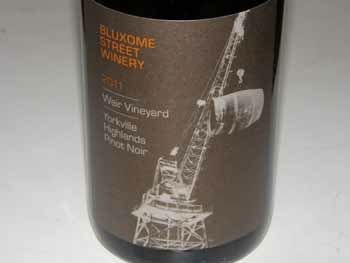
14.5% alc., pH 3.55, 300 cases, $55. I have been a long time fan of the Castalia Pinot Noirs produced from Rochioli Vineyard fruit by winemaker Terry Bering, the cellarmaster at Rochioli. This wine is 50% Rochioli Riverblock fruit and 50% from a 20-year-old block of Rochioli West Block selection planted in another vineyard on Westside Road incorporated into J. Rochioli Russian River Valley Estate wine. Aged 15 months in 20% new French oak barrels. The Castalia wines typically need time to evolve and I found this wine proved that dictum. I first tasted the wine last February and thought it was very good but not extraordinary then. My recent tasting in October 2013 found the wine had blossomed into something very special. Medium reddish-purple color in the glass. Alluring aromas of Bing cherries, strawberries, spice and musk literally jump out of the glass over time. The flavor of cherry syrup caresses the palate complimented by notes of spice and vanilla. The classy, lush fruit is perfectly buffered by ripe tannins and brought to life by bright acidity. The lengthy finish is simply gorgeous. Quintessential Russian River Valley richness, yet sleek, balanced and refined.
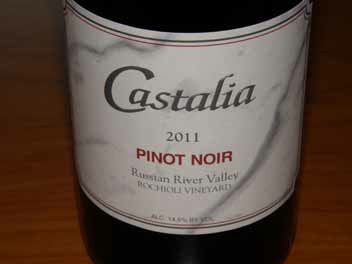
14.9% alc., 570 cases, $60. Yields on the estate’s 16 acres were very low in 2010. A combination of 20-yearold and 30-year-old vines. Moderately dark reddish-purple color in the glass. Aromas of fresh crushed Bing cherries and baking spices draw you into the glass. Remarkable fullness of sappy, black cherry flavor on the middle palate with hints of cola and spice, carrying over to a generous, fruit-filled finish. Despite its concentration and structural bones, the wine is light on its feet and a delight to drink. The velvety soft texture is of the type that drives Pinot lovers mad. Beautifully composed and seamless in every way.
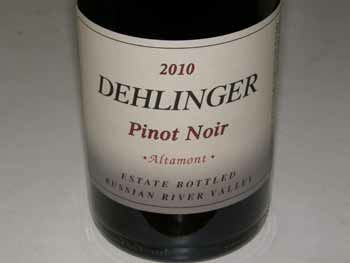
13.5% alc., 383 cases, pH 3.56, TA 0.62, 383 cases, $58. This 8-acre vineyard is located at the far western edge of the Green Valley on Stoetz Ridge. Low vigor soil and tiny crop. Clones are 667, lesser amounts of 777 and a touch of 115. Aged 17 months in 50% new French oak barrels. Medium garnet color in the glass. Terrific nose that draws you into the glass with bright aromas of wild berries, black cherries, tea leaf and spice. Super delicious and captivating, with layers of enticing flavors including black cherry, black raspberry, plum reduction sauce, vanilla and spice. The depth of flavor really sets this wine apart. The oak is complimentary, the mouth feel is creamy, and the lengthy finish offers a refreshing grip. A scintillating wine.
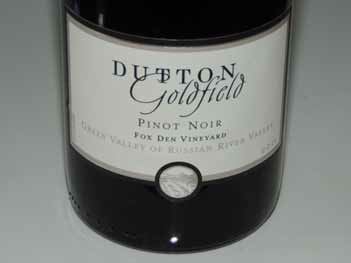
14.5% alc., pH 3.60, TA 0.59, 99 cases, $95. Harvest began September 14, a full three weeks later than usual. Coastal fog led to a leisure harvest and picking concluding four days later. Dijon 667 and 777 clones and Swan selection planted on 3309 rootstock were chosen for the fruit qualities that distinguish the Sessions Vineyard. 100% de-stemmed. Aged 18 months in 75% new French oak barrels.Moderately dark reddish-purple color in the glass. High-spirited aromatics of black cherries, black raspberries, cedary oak and spice lead to a mouth coating palate featuring dense flavors of black cherry infused cola, dark plum and exotic spice. The fruit is perfectly ripe and flat-out delicious, making a statement on entry and an impression on the finish which is of uncommon length. The wine is structured but not hard, and the acidity is beautifully integrated. A very special wine that stands out even at this young age. Even better on the nose and palate the following day from a previously opened and re-corked bottle, indicating it will benefit from further cellaring. One of the best Pinots California has to offer in this vintage.
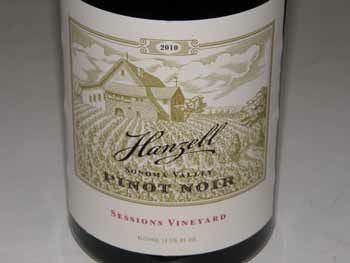
13.5% alc., pH 3.53, TA 0.60, 550 cases, $75. This 34.5-acre vineyard surrounds the Freestone winery facility and is 8 miles from the Pacific coast. Aged in 70% new and 30% two and three-year-old French oak barrels. Moderately dark reddish-purple color in the glass. Shy aromas of dark cherries and blackberries with subtle spice and oak highlights. Impressive concentration without weight, offering earthbound flavors of dark red and black fruits including purple grapes with a hint of spice and tobacco-laced oak. Impeccable balance and a finish that hangs on tenaciously. The next day when sampled from a previously opened and re-corked bottle, the wine had blossomed further, becoming an “Oh my God” wine.
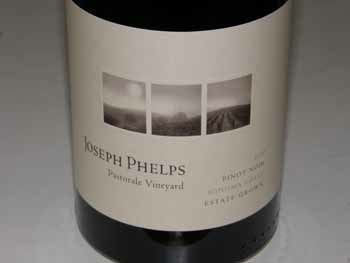
13.4% alc., $70. A special vineyard with a strong maritime-influenced terroir located near the town of Occidental across the street from Summa Vineyard. Touched daily by morning fog and light wind, the soils are ocean floor-derived sandy loam. Medium reddish-purple color in the glass. This wine has one of those noses that brings you to your knees. Profuse aromas of perfectly ripe cherries and berries with an exotic spice and floral accent. Delicious middleweight flavors of cherry pie glaze, dark red berry jam, cola, spice and complimentary oak, finishing with impressive power and persistence. A very polished wine with everything in balance. Even better the following day from a previously opened and re-corked bottle. Thieriot Vineyard Pinot Noir is what first hooked me on Littorai years ago, and I relish the addiction. It just doesn’t get any better than this.
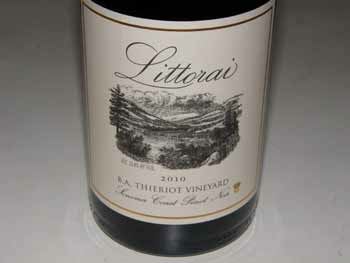
13.6% alc., $75. Sourced from Burt Williams’ estate vineyard planted to cuttings from the Rochioli Vineyard, DRC suitcase selections, clone 23 and Dijon clones 115, 777 and “828.” Modest whole cluster, aged in new and used Francois Fréres French oak barrels and bottled unfiltered. Last Pinot Noir crafted by Burt Williams. Moderately dark reddish-purple color in the glass. Alluring aromas of black cherries, spice, white pepper and sweet pipe smoke. Waves and waves of savory fruit, offering tantalizing flavors of brandied black cherries, black raspberries, anise and tar. Very polished with balanced tannins and well-honed acidity. The unbelievably long finish lasts over a minute and I am not exaggerating. The more you taste, the more you like this special wine. Even better the next day from a previously opened and re-corked bottle. Williams Selyem Pinot Noir of the early 1990s De Ja Vu. Burt is a modest soul, but calls this, “A wine apart.”
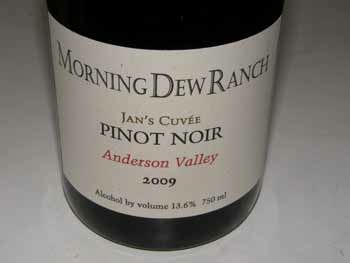
14.4% alc., 235 cases, $48. Adjacent Garys’ Vineyard but rows are oriented differently so the winds pass through the vineyard more evenly and because it is more fertile, the vines are planted closer together. Fourth leaf. Pisoni selection and Dijon 667. Moderately dark reddish-purple color in the glass. Aromas of dark currants, ripe plum and brandied raisins. Delicious and harmonious, with gorgeous flavors of black plum and blackberries with a note of spice and citrus in the background. The fruit really sparkles in this wine and lasts and lasts on the finish that offers a teasing hint of spice and mocha. Spectacular the following day from a previously opened and closed bottle showing an Elvis on velvet mouth feel. A complete wine that is very refined and sophisticated and clearly the jewel of this vintage for Siduri.

12.8% alc., 29 cases, $100. 100% clone ”828” from Guidicci Vineyard (MonoClone®). One site, one clone, one cooperage. Rigorous cluster selection, very low yields, 30% whole cluster, aged 16 months in 20% new French oak barrels. Moderately light reddish-purple color in the glass. This is a wine that benefits greatly from decanting now. Wonderful aromas of black cherries, forest floor and spice. Layered flavors of black cherries, plums and black raspberries with an earthy, savory and spicy undertone. A touch of smoky, vanillin oak adds interest. Surprisingly concentrated and robust at such a low alcohol percentage. Supple tannins make for a seductively silky mouth feel and bright acidity leaves the finish clean and vivid. Even better the next day from a previously opened and re-corked bottle and still pumping out pleasure two days later. Tremendous aging potential. A kick-ass California Pinot that is powerfully flavored, yet elegant.
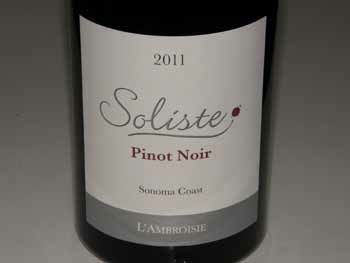
12.8% alc., pH 3.37, TA 0.62, 50 cases, $80. 6-acre vineyard planted in 1981. Henry Ayrton’s Block was formerly known as the B Block. Martini clone planted in well-drained, very shallow fractured shale soil. 30% whole cluster, spontaneous fermentation. Aged 18 months in once filled 3-year-old air-dried, tight-grained French oak barrels. Bottled unfined and unfiltered. Moderately dark reddish-purple color in the glass. The nose is reserved, offering delicate aromas of spiced berries. Delicious entry and exit featuring middleweight array of blue and black berries with a welcome accent of oak in the background. Impressive weight and persistence. Not fully giving yet and definitely needs time in the cellar. The fruit really opened up and sang the following day from a previously opened and re-corked bottle and was the best wine of the three terrific wines from the 2011 Rapley Trail stable.

2013 California Pinot Noir Second Team All-Americans
14.5% alc., 100 cases, $120. A best barrel blend from Donum Ranch crus. Aged in 25% new French oak barrels. Moderate reddish-purple color in the glass. Enticing aromas of fresh black cherries, strawberries, spice and complimentary oak vanillin. A little richer and more structured than the 2010 Estate Gold Label bottling. The wine offers layers of flavor including very ripe black cherry, black currant, dark chocolate, grilled meat, and tantalizing oak. Much better the next day from a previously opened and re-corked bottle showing better integration of oak, effusive aromas that jumped out of the glass, and a finish to die for. Exceptional.
14.2% alc., 287 cases, $55. 40th anniversary of Joseph Swan Vineyards and the 30th anniversary of Rod Berglund’s first year of making wine. Aged in 66% new French oak. Moderately dark reddish-purple color in the glass. The most expressive nose in the lineup showing vibrant aromas of black cherries, dark plums, mushroom, cardamom spice and a hint of vanilla. Delicious earth-kissed core of dark cherries, raspberries and plums. Rich and full-bodied, with balanced tannins and acidity making the wine quite approachable now. Great the next day from a previously opened and re-corked bottle. Could drink now because the tannins are not aggressive, but best to hold for at least another five years.
14.7% alc., pH 3.57, TA 0.59, 211 cases, $78. Vineyard is located in the Sebastopol Hills, an area featuring morning and evening fog, breezy afternoons, and bright, mild afternoon sun. Cooler temperatures lead to a longer hang time and this vineyard is usually the last to be harvested. Clones 115, 667 and Pommard. Yields 2.1 tons per acre. 100% de-stemmed. Aged 16 months in 50% new French oak barrels. Tighten your seat belt when you open this one. Moderately dark reddish-purple color in the glass. With a nose you could drink, and a core of liquid magic that you can drink, this is one great wine. Aromas of dark red berries sprinkled with vanilla cream lead to sumptuous flavors of black cherries, blue and dark red berries, spice and dark chocolate. Power without weight, juicy without being cloying, this beautifully balanced wine is soft in the mouth and finishes with length and opulence. The pick of the litter.
14.5% alc., pH 3.55, TA 0.66, 438 cases, $50. Released June 2013. One of the first vineyards in the Santa Lucia Highlands and one of the original vineyards of Hahn Estate. It is the southernmost of the vineyards of Lucienne and located at the highest elevation, with the least influence from marine fog. Clones are Mt. Eden, Jardini, Pommard 5 and 2A. 100% de-stemmed, 3-day cold soak, proprietary yeast, aged 13 months in 42% new and 58% neutral French oak barrels. Moderately dark reddish-purple color in the glass. Intoxicating aromas of fresh black cherries, dark red berries, cardamom spice and a hint of toasty oak. Discreetly concentrated flavors of dark cherries and berries with a complimentary riff of spice and oak. Outstanding harmony, very smooth and sensual, with an appealing cherry tang on the juicy and lengthy finish. The wine continues to pick up charm over time in the glass. Very easy to drink now, but should get even better with another year in bottle. Very impressive, even extraordinary.
14.3% alc., 115 cases, $55. From a 1.86-acre block of 1690 vines of clone 115 planted in 1997 on 104-14 rootstock. Aged 11 months in 100% new Cadus French oak. Moderately light reddish-purple color in the glass. Aromas of earthy dark red fruits with a touch of red rose floral scent in the background. Impressive attack of mouth coating, silky and well-spiced cherry fruit complimented by perfect oak integration and supple tannins. A dreamy wine of great flavor that displays impeccable balance. Clone 115 is one of the few Dijon clones that can make a great stand-alone wine.
14.1% alc., 128 cases, $55. Pommard clone. 100% de-stemmed and aged in 33% new French oak. Moderately light reddish-purple color in the glass. Lovely aromas of fresh Bing cherries, ripe strawberries and cardamom spice which maintain over time. Delicious middleweight core of dark cherry flavor with accents of cola, anise and spice. Enticing finesse and supple, well-balanced tannins. Ready to drink now but the balance will keep this wine fresh for years. Like cherry pie day at cooking school: cherries, baking spices and very interesting results. Will work beautifully at the table, complementing rather than fighting with food.
13.7% alc., $36. Sourced from Meadowridge Vineyard in Corralitos blended with a small amount of 2010 Pinot Noir from another Santa Cruz Mountain vineyard. Dijon clones. Harvested before early autumn rains. Flavor ripeness was achieved at modest sugar levels. Extended barrel time. Moderately deep purple color in the glass. Lovely perfume of dark berries, fresh picked plums and spice. The aromas are captivating. My notes say WOW on entry. Really delicious, moderately intense flavors of dark berries, black cherries and plum with a hint of spice. The fruit reaches every nook and cranny in the mouth, expanding to finish with unbelievable length and aromatic focus. A complete, harmonious wine of exceptional quality from a little known but experienced garagiste producer in Aptos.
14.5% alc., 143 cases, $40. This 12-acre vineyard is south of Laetitia Winery on the eastern side of Highway 101. Primarily 667 with a small amount of 777. 33% whole cluster. 50% inoculated and 50% native fermentation. Aged 17 months in 50% new Francois Frères French oak barrels. Unfiltered. · Dark purple color in the glass. Scent of loganberry jam, raw beef, and roasted plum. Deep plum flavor with a subtle sidecar of spice, dark chocolate and citrus. Very seductive velvety mouth feel with a robust, long, long finish. Beautiful integration of oak. This wine can be a ball buster, but it is a chiseled ballerina in this vintage that is oozing charm. Always a terroir-driven wine of distinction, but more giving in this vintage.
14.4% alc., pH 3.75, TA 0.55, 275 cases, $59. Release fall 2013. This vineyard is owned and managed by Thomas Rivers Brown and Fred Schrader and farmed by Ulises Valdez. Located in the remote coastal mountains near Annapolis, it is surrounded by redwoods at 1100 feet above the Pacific Ocean. Yields are minuscule with concentrated flavors. Clones 115, 667 and 777. Aged in 50% new French oak barrels. Medium reddish-purple hue in the glass. The perfume draws you into the glass with aromas of darker plum and berry with notes of balsam and salt air. Delicious middleweight core of vibrant plum, black cherry, berry and cola flavors clothed in soft, lacy tannins, finishing with a lingering memory of cherry liquor. Very smooth in the mouth and discreetly sappy, this wine displays impeccable balance. Memorable.
13.1% alc., pH 3.52, TA 0.56, $46 (Magnums too, $90). Released April 27, 2013. Sourced from the estate Monument Tree Vineyard and Ferrington Vineyard. Moderately light reddish-purple hue in the glass. Glorious aromas of fresh black raspberry jam, potpourri and spice. I just love that smell. Really delicious marriage of dark berries and cherries with a subtle mocha note. The ripe fruit really pops, reaching every corner of the mouth, and finishing strong and satisfying. There is an appealing tension and focus to this wine and the satiny texture is captivating. An incredible effort in a difficult vintage and my kudos to winemaker Ben Cane. Still great the following day from a previously opened and re-corked bottle when my family polished it off.
2013 California Pinot Noir Honorable Mention All-AmericansAll these wines received the Pinot Geek designation and/or a score of 94 or more in 2013.
Trinity County
2005 Dubakella Trinity County Pinot Noir
Humboldt County 2011 Briceland Vineyards Reserve Humboldt County Pinot Noir Mendocino County
2011 Anthill Farms Comptche Ridge Vineyard Mendocino County Pinot Noir
Mendocino Ridge 2011 Bravium Signal Ridge Vineyard Dragonfly Block Mendocino Ridge Pinot Noir Anderson Valley
2010 Benovia Savoy Vineyard Anderson Valley Pinot Noir
Yorkville Highlands
2011 SPELL Weir Vineyard Yorkville Highlands Pinot Noir
Cole Ranch 2010 Esterlina Cole Ranch Reserve Cole Ranch Pinot Noir Sonoma Coast
2009 COBB Jack Hill Vineyard Sonoma Coast Pinot Noir
Russian River Valley
2010 Alysian Floodgate Vineyard Rock Hill Russian River Valley Pinot NOir
Sonoma Valley 2010 Hanzell Sonoma Valley Pinot Noir Carneros
2010 Donum West Slope Carneros Pinot Noir
Santa Cruz Mountains
2010 McHenry Vineyard Santa Cruz Mountains Pinot Noir
Santa Lucia Highlands
2011 Kosta Browne Garys’ Vineyard Santa Lucia Highlands Pinot Noir
Santa Maria Valley
2010 Byron Monument Santa Maria Valley Pinot Noir
Santa Barbara County 2010 Pence Ranch Estate Uplands Santa Barbara County Pinot Noir California 2011 Kosta Browne 4 Barrel California Pinot Noir
2013 California Value Priced Pinot Noir First Team All-AmericansAll wines were priced at or below $35 or less and received ratings of Outstanding or above.
13.8% alc., $24.99, screw cap. Vinified by fifth generation Belle Glos Wines winemaker Joseph Wagner whose family founded Caymus Vineyards. Alouette is the French name for lark, a songbird that is a familiar sight in vineyards along the coast of California. The lark has been romanticized over time and serves as the muse for this wine. 2012 was an exceptional vintage in California and the high quality of the fruit from the coastal regions of Sonoma County show through in this wine. Aged in 60% new French oak barrels for 9 months. · Aromas of red grapes, spice, violets, toast and oak vanillin lead to deeply flavored notes of cherries, strawberries and sarsaparilla with welcome accents of spice and oak. Very soft and silky in the mouth with balanced tannins that make for easy drinking. Similar to the Meiomi bottling by the same producer, but more charm and restraint.
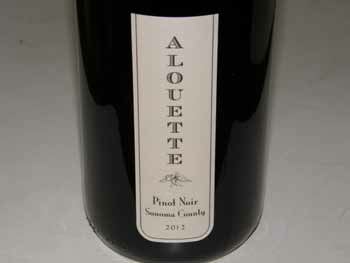
14.6% alc., 700 cases, pH 3.68, TA 0.58, $28. Sourced from four highly regarded vineyards (RLR, Moore Ranch, Dutton-Lorenzo, and Hurst). Clones 113, 114, 115, 667, 777 and Pommard. 100% de-stemmed, several week post-fermentation maceration, aged 17 months in 37% new French oak barrels. Moderately light reddish-purple color in the glass. Aromas of fresh Bing cherries, baking spices and sandalwood spring from the glass. Delicious mid weight black cherry core that is thoroughly satisfying. Impressive structure and power for this vintage, yet displaying welcoming finesse. The finish is noticeably powerful and lingering.
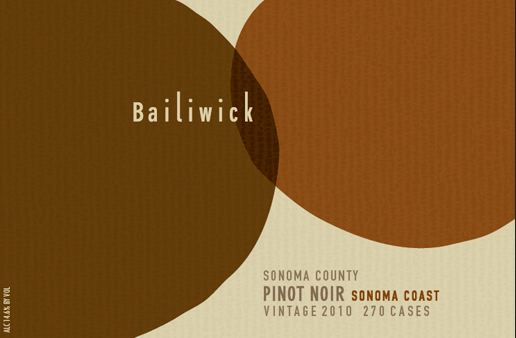
14.3% alc., pH 3.47, TA 0.61, 288 cases, $34. The vineyard is on a steep mountainside three ridges in from the Pacific Ocean at 2,642 feet elevation. Relatively shallow and rocky soils. Wide variety of clones and selections including Pommard and Swan. Yields 0.65 tons per acre. 16% whole cluster, 7-day cold soak. Native fermentation in one-ton fermenters. Aged 11 months in 33% new 4-year air-dried Francois Frères oak barrels. Unfined and unfiltered. Moderately light reddish-purple color in the glass. Aromas of cherries, deep red rose petals and pine needle. Tasty with good intensity, featuring flavors of black cherries black raspberries and pomegranates with a hint of tea. Impeccable balance with mild tannins and juicy acidity, finishing with impressive intensity. Blossomed beautifully the following day from a previously opened and re-corked bottle, displaying a dreamy, velvety mouth feel and seductive flavors.
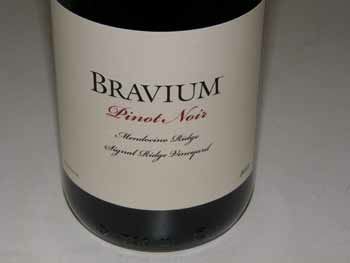
13.4% alc., 50 cases, $29. Formerly Le Chien Blanc Vineyard. Located at 1600 feet elevation northwest of Briceland Vineyards. Slowed ripening in this vintage so more acid and less tannin than typical for this site. Aged 18 months in oak barrels. Unfined and unfiltered. Medium reddish-purple color in the glass. The nose is intoxicating with fresh aromas of racy raspberry, red cherry, spice and sandalwood. Refreshingly crisp on the palate with charming flavors of fresh red raspberries and cherries caressed by supple tannins and framed by mouthwatering acidity. Not a fruit bomb by any means, but plenty of flavor without weight and great pinotosity.
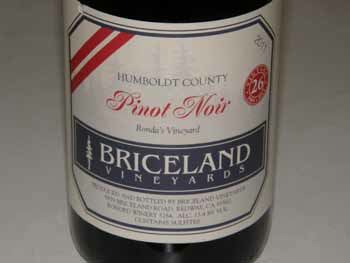
14.5% alc., $36. From Santa Barbara’s first commercial vineyard. Clones 114, 667 and Pommard. Small yields. Moderately dark reddish-purple color in the glass. The aromatics are captivating with a complex array of black raspberry, blackberry, spice and floral aromas which hold up well over time in the glass. The dark red and black berry fruits are perfectly ripe and bright. There is a complimentary accent of spice and oak with an earthy undertow. This wine offers impressive clarity and tension and is very easy to drink now. I liked the wine increasingly over time.
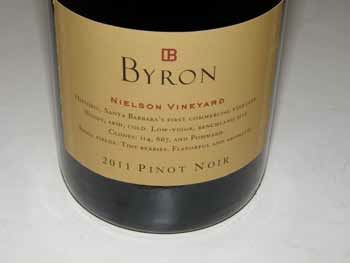
14.1% alc., $35, screw cap. From select vineyards in the Anderson Valley. 16-day total maceration, fermented using native and select yeasts, aged 10 months in 14% new oak barrels. Unfined and unfiltered. Moderately dark reddish-purple color in the glass. Reserved but pleasant aromas of red and black berry mash with a hint of spice and dried rose petals. Hits the mid palate with vigor, offering deliciously rich black cherry, blackberry and plum flavors accented with Christmas spice including clove. Highly approachable and comforting with supple tannins, bright acidity, and a glorious finish of uncommon intensity and length. By this one by the case for your holiday parties.
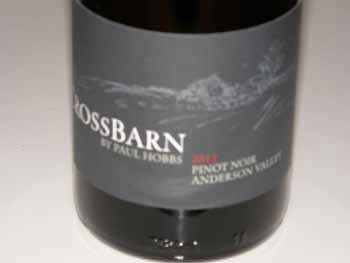
14.3% alc., 250 cases, $28. Sourced from Keller Estate (El Coro Vineyard) in the Petaluma Gap. Clones 667, “828,” and La Tache. Aged in seasoned oak. Moderately light reddish-purple color in the glass. Fresh uplifting aromas of strawberries, red cherries and sandalwood. Light and elegant, yet flavorful and satisfying, with the vivid taste of red cherry, baking spice, and brewed tea. Beautifully integrated tannins and acidity, offering a relaxed drinking experience. I was taken by the finesse in this wine. An entry level wine that sparkles. Very good, even outstanding at this price point.
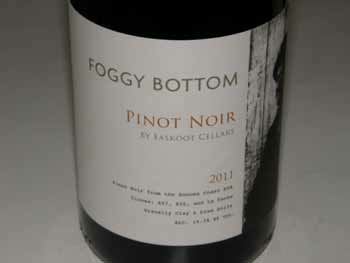
13.63% alc., pH 3.79, TA 0.54, 19,800 cases, $17. From select vineyards in the Arroyo Seco region. Dijon clones are the backbone. 76% Pinot Noir and 24% Valdiguié (winemaker Steve Peck says Valdiguié goes beautifully with Pinot Noir). After a 3-day cold soak, fermented in 6-ton and 12-ton lots in open-top punch down tanks. Light pump overs with daily punch downs for 5 to 10 days. 100% MLF. Matured in stainless steel with 10% aged in neutral French oak barrels. Medium reddish-purple color in the glass. Lovely nose with aromas of dark berries, rose petals, and exotic spices that retain interest over time. Delicious and entirely seductive, with flavors of dark cherry and berry with complimentary notes of spice, anise and oak. Soft in the mouth, with mild tannins, commendable balance, and very respectable finishing intensity. The addition of Valdiguié gives this wine a unique flavor profile that is quite interesting. A superlative value priced wine that is widely available in the retail marketplace.
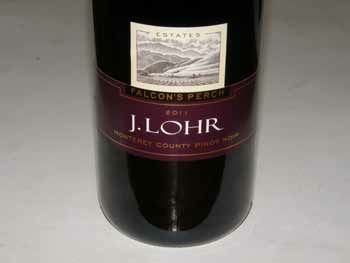
14.2% alc., 656 cases, pH 3.71, TA 0.56, $35. Magnums available. Sourced from Rio Vista Vineyard, Garey Vineyard, Nielson Vineyard, Sierra Madre Vineyard and Buena Terra Vineyard. 53% from Santa Maria Valley and 47% from Sta. Rita Hills. Moderately light reddish-purple color in the glass. Pleasing aromas of black cherries, ripe berries and echoes of oak. Very tasty black cherry core with hints of red hard candy and spice and an earthy undertone. A very approachable mid weight offering with mild tannins and a silky mouth feel. Almost weightless. You won’t find a better AVA blend in the marketplace.
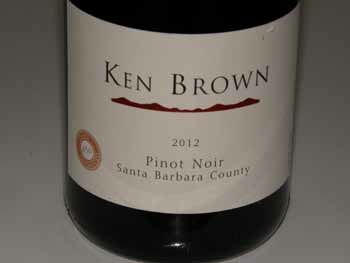
13.5% alc., pH 3.74, TA 0.56, $25 (but discounted to $19.99 in many retailers). Sourced from select vineyard sites in proximity to the Pacific Ocean. Clones 667, 777, 115, Pommard, 2A, Martini, Flowers, Calera, “828,” and 23. 100% de-stemmed, 3 to 4-day cold soak, fermented in small, open-top tanks, minimal post-fermentation maceration, aged in 26% new (98% French) oak barrels for 6 months. Racked only once for blending just before bottling. Moderately light reddish-purple color in the glass. Enticing aromas soar from the glass including cherries, berries, purple grapes and earthy flora. Very tasty juice with excellent depth and length offering an arsenal of flavors including dark red strawberries and cherries, cola and gregarious spice with a dusting of oak enhancing the experience. Nicely crafted, with supple tannins and a long, caressing finish. As good or better than many Pinot Noirs in the marketplace costing twice as much.

14.3% alc., pH 3.71, TA 0.65, $25 (discounted to less than $20 by some retailers). 100% estate grown. A combination of fruit from mature vines and young Pommard and Dijon clone vines. Moderate reddish-purple color in the glass. Lively aromas of fresh black cherries, blueberries and black raspberries with a hint of oak spice. Very smooth on entry and flavorful, offering mid weight tastes that echo the aromas with accents of oak vanillin, black tea and spice. Admirable finesse, with a rousing finish that is quite generous.
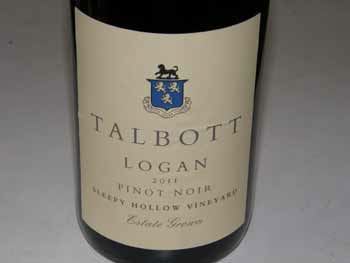
2013 California Value Priced Pinot Noir Honorable Mention All-AmericansAll wines priced at or below $35 and received a rating of Very Good or above. Humboldt County
2011 Briceland Vineyards Phelps Vineyard Humboldt County Pinot Noir
Anderson Valley 2011 Littorai Anderson Valley Vin Gris Sonoma County 2012 Bruliam Sonoma County Rosé Sonoma Coast
2011 Bravium Sonoma Coast Pinot Noir
Russian River Valley
2011 Davis Bynum Jane’s Vineyard Russian River Valley Pinot Noir
Carneros
2011 Castello di Amorosa Los Carneros Pinot Noir
Monterey County
2011 Carmel Road Arroyo Seco Monterey Pinot Noir
Santa Lucia Highlands
2011 August West Santa Lucia Highlands Pinot Noir
San Luis Obispo County 2011 Sinor-LaValle San Luis Obispo County Pinot Noir Santa Maria Valley
2011 Byron Santa Maria Valley Pinot Noir
Santa Barbara County 2011 Pali Wine Co. Huntington Santa Barbara County Pinot Noir Sta. Rita Hills
2011 Longoria Lovely Rita Sta. Rita Hills Pinot Noir
Central Coast 2011 Birichino Saint Georges Central Coast Pinot Noir California
2011 Angeline California Pinot Noir
2013 Oregon Pinot Noir First Team All-Americans
13.0% alc., pH 3.60, 363 cases, $68. 100% clone 667 planted in basaltic-origin (volcanic) soils. This 100-acre vineyard was established by Edward and L.S. Koo in 1981. Adelsheim replanted on of the ideal sections of the vineyard. A late ripening site. Fifth single vineyard bottling. Aged 10 months in 33% new medium toast French oak barrels. Medium reddish-purple color in the glass. The nose is striking with bright aromas of Bing cherries, raspberries, and spice. Outstanding depth and length of flavor featuring a core of dark red cherries and berries with a hint of graham, cola and spice. Seductively ethereal in the mouth, with firm, supportive tannins, and a long, long, long finish. A brilliant wine with superb balance. Still extraordinary when tasted the following day from a previously opened and re-corked bottle.
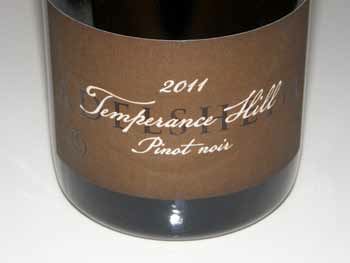
12.8% alc., pH 3.45, TA 0.66, 167 cases, $58. The Flat Block is one of seven different sections of Pinot Noir planted over 37 acres in the estate vineyard. It was planted in 1979 on a flat table of the vineyard and is 100% own-rooted Pommard clone. The soil is gravelly and of a different mineral composition than the neighboring Southeast Block. This 3.3-acre block consistently has a distinctive character, usually offering the most refined and elegant Pinot Noir. Wines from Flat Block have been bottled separately since 1991. Moderately dark reddish-purple color in the glass. This is one of those wines that makes you sit up and take notice. Marvelous aromas of black cherries, damp earth, and warm s’mores. Earthy, exotic, and erotic black cherry and black berry flavors with a compliment of spice. The fruit is robed in ripe, firm but polished tannins and invigorated with bright acidity. This giving wine is blessed with a charge of black cherry flavor on the dancing finish. Pure seduction.
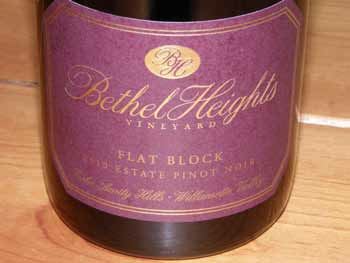
12.6% alc., 119 cases, $45. This vineyard is old by Oregon standards as it was planted in the early 1970s. Brian likes to say he was still wearing diapers when the vines went into the ground in this vineyard. Moderate reddish-purple color in the glass. This wine reminds of cherry pie baking day at cooking school. Deliciously flavored with ripe cherries and baking spices with a hint of sandalwood and wintergreen. Crisp and juicy with a long, spirited finish. Hard to put your finger on the reasons for it, but this wine grabs your interest and holds it. An old vine treasure.

13.5% alc., $58. From the second block planted in the Estate Vineyard in 2001. 4 acres of 667, 777 and 115 planted in Willakenzie marine sedimentary soil. · Medium reddish-purple color in the glass. Stunning and nearly overwhelming in aromatic intensity featuring a deep perfume of black cherries, blackberries and plum. Delicious core of ornate black stone fruits that make you sit back and take notice. A touch of smoky oak and dried herbs add interest. Impressive fullness and concentration on the palate without being jammy. Seamless with perfect integration of tannins and acidity. A poster child for Oregon Pinot Noir.
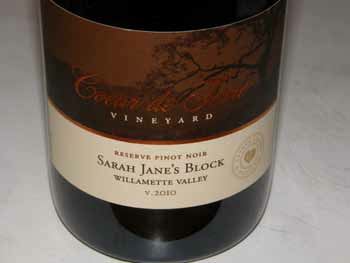
13.5% alc., pH 3.69, TA 0.59, 363 cases, $55. This vineyard was originally planted in 1982 and is one of the oldest vineyards in the Eola-Amity Hills AVA, and home to some of the oldest vines on the Cristom estate. It is situated on a gently sloped east facing hillside between 480 and 615 feet above sea level. Named for owner Paul Gerrie’s mother, the first single vineyard estate Marjorie was released in 1994. The soil is primarily Jory in type. Phylloxera struck the vineyard in 2000, and beginning in 2007, replanting was initiated with Dijon clones 113, 115, 777, Pommard and Wädenswil grafted onto phylloxera-resistant rootstocks. The vineyard produces very small, concentrated clusters. Aged 17 months in 53% new Burgundian cooperage. Moderate reddish-purple color in the glass. Bombastic and exotic aromas of red and black cherries, whole cluster spice and floral notes, smoky oak, incense and licorice. Delicious core of cherry fruits which are broad in the mouth and supported by integrated notes of spice, fennel, anise and mocha-laden oak. A special wine that is built for the long haul, with firm, fine-grain tannins, refreshing acidic verve and a lengthy finish of great energy. A whole cluster triumph that really impressed me.
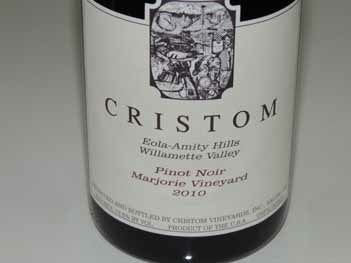
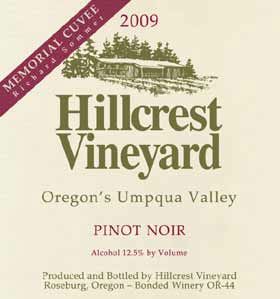
13.5% alc., $45. A barrel selection of the finest barrels representing the best parts of the 30-acre vineyard. The site is a steep south-facing slope just east of the town of Yamhill. Shallow soils, dense spacing and a diversity of clones (Pommard, 1125, 114, 777 and 667). Medium reddish-purple color in the glass. The nose is captivating, offering fresh and vibrant aromas of fresh cherry tart, red raspberry, and Xmas spice that become more generous over time in the glass. A polished wine with admirable finesse, displaying a middleweight core of juicy cherry and berry fruits with a complimentary note of spice and sous-bois. The soft, but evident tannins are well balanced the finish is plush with spiced cherry goodness. Satisfying now, but still young and relatively closed. Much more expressive and enjoyable the following day from a previously opened and re-corked bottle. This wine will definitely benefit from more time in the cellar, but when you do bring it out, the wine will be a cause for celebration.
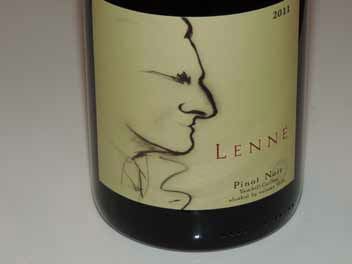
13.6% alc., 75 cases, $65. From the south block of this estate with vines dating to 1980. Extreme crop thinning and the extra small berry size in this vintage led to special flavors. Southwest facing hillside with Jory soils. 100% Pommard clone. Moderately dark reddish-purple color in the glass. I was searching for proper descriptors to do justice to the nose. Dreamy aromas of black raspberry jam on a warm croissant, black cherries, exotic rose petals, and a hint of truffle. Delicious and luscious on the palate with perfectly ripened fruit flavors of black cherry and black raspberry with riffs of baking spice, dark chocolate, vanilla, sassafras and rose hips tea. Highly flavorful and full of sappy fruit goodness, but not imposing. Beautifully composed and harmonious, with silky tannins, balanced acidity, and an orgasmic finish. Scary to think it will get even better with some time in the cellar. My highest rated Oregon Pinot Noir in 2013.
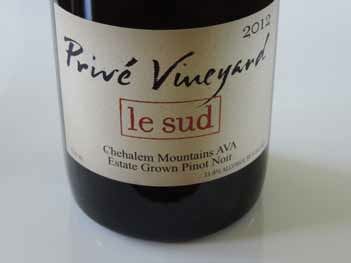
13.6% alc., 100 cases, $55. 100% Pommard clone planted in Jory soil (rootstock dates to 1980) on a southwest facing hillside. Dark reddish-purple color in the glass. The nose is complex and captivating initially, with aromas of black raspberry, black currant, licorice, spice and purple rose petals. The wine hits the mid palate with an unctuous core of black cherry and black raspberry fruit caressed by soft tannins and brought to vivid heights with bright underlying acidity. Very smooth and sexy, with a gorgeous finish replete with perfectly ripened blackberry fruits. Darker fruits, earthier and a little more sap and tannin than the le sud, with more evident acidity and a brighter finish. This wine is like le sud’s teenage sister - more rebellious, untamed and immature. Much better when re-tasted later in the day. Awesome.
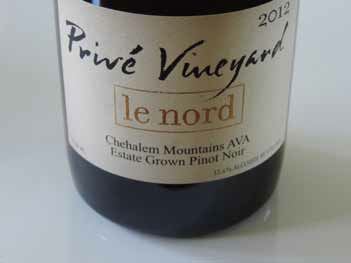
14.4% alc., 127 cases cases, $45 . Released November 2013. Originally this 53-acre vineyard was a “no-expense- spared” project planted in 2006 and financed by CALPERS. Portions of it were eventually acquired by a California wine label. Sourced from blocks planted to clone 777 on Willakenzie soils. Moderately dark reddish-purple color in the glass. Aromatically uplifting with hi-brow scents of fresh black cherry, blackberry and a hint of vanilla. Deliciously rich and sappy on the palate with layers of fruits including blackberries, black cherries, plums and currants. Hints of cola, spice and vanilla add interest. Very soft and luxurious on the palate. The fruit is well-buffered by a substantial tannic backbone. The finish is remarkably long, generous and decadent. I have rarely experienced a single clone 777 Pinot Noir this appealing.
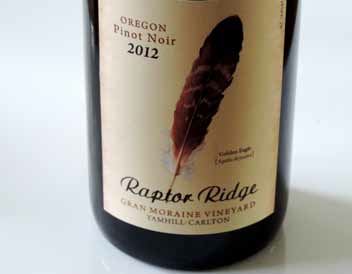
13.0% alc., 99 cases, $85. Sourced from White Rose Vineyard and Luciole Vineyard. Pommard, 115 and 777 clones in Jory soil. Harvested November 4 (White Rose Vineyard) and November 1 (Luciole Vineyard). Fermented with 75% whole cluster on average. 8 day pre-fermentation maceration, total skin contact 23.5 days. Aged 16 months in 25% new French oak barrels. Moderately light reddish-purple color in the glass. The nose draws you into the glass with aromas of dark cherries, dried rose petal, exotic spice and a hint of smoke. Delicious from the get-go with a rush of spiced cherry and strawberry fruits on entry, penetrating every nook and cranny in the mouth, and finishing with uncommon grace and generosity. The spice is particularly evident on the finish. Despite the flavor onslaught, this wine remains elegant and refined. The healthy tannic structure predicts a long life ahead. A very special wine.
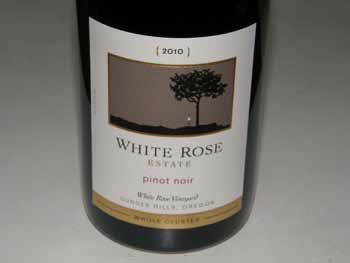
2013 Oregon Pinot Noir Second Team All-Americans
13.2% alc., 236 cases, $75. A barrel selection from estate fruit. · Moderately dark reddish-purple color in the glass. Shy nose picking up interest and intensity over time in the glass offering alluring aromas of dark red cherries and berries accented with nutmeg spice. Seamless and soft in the mouth, even creamy, with a full-bodied core of deep red cherry and berry fruits backed by well-integrated oak. Similar to the regular bottling in flavor but more stacked and packed. Remarkable phenolic ripeness and intensity at a relatively low alcohol percentage. Dreamy.
12.9% alc., pH 3.45, TA 0.65, 135 cases, $50. From a 6-acre section of the estate vineyard planted in 1979 in deep red clay soil that is volcanic in origin. The vines are 100% own-rooted Pommard clone. 100% de-stemmed fruit. Aged 11 months in 50% new French oak barrels. Wines from Southeast Block have been bottled separately since 1991. Moderately dark reddish-purple hue in the glass. Scintillating aromas of dark cherries, raspberry jam and cardamom spice. Intensely flavorful, tasting of ripe black fruits including cassis, and brewed black Oolong tea. The fruit has remarkable staying power in the mouth and finishes with pleasing crispness and length. An immensely satisfying wine.
13.5% alc., 59 cases $58. This 3-acre block was the original planting in the Estate Vineyard circa 1999. It is composed of 8 clones and referred to as the mother block since it supplied the cuttings for all other Pinot Noir vines in the Estate Vineyard. Willakenzie sedimentary soils.This wine is dedicated to Renelle Lynn Neal (Scott’s mother). Moderate reddish-purple hue in the glass. Effusive aromas of black cherry tart, spice, crusty brioche, and ground savory. Rich and full-flavored, with a layered array of red and purple fruits complimented by a hint of cola and savory herbs. The mouth feel is velvety and the bright acidity brings vibrancy to the wine. The finish goes on and on. A very special wine that will please every Pinot connoisseur.
13.0% alc., $35. Self-rooted, dry-farmed Pommard clone planted in 1976 in Laurelwood soil at 300 to 500 feet. Aged 13 months in 50% new French oak barrels. Moderately light reddish-purple color in the glass. This is one of those wines that you know is exceptional from the first sip. The beguiling aromas draw you in with notes of cherries, strawberries, nutmeg and other spices. Smooth, seamless, polished and flat out delicious, this wine sports middleweight flavors of perfectly ripened dark red cherries, raspberries, spice and dark chocolate. Supple tannins and a satisfying cut of acidity in the background. This wine is assertive without weight, showing restraint and modesty, yet delivering a load of pleasure. Quintessential Oregon Pinot Noir.
13.5% alc., $48. Vineyard was planted in 1996 with cuttings from Roosevelt Vineyard. Willakenzie soils. Moderately dark reddish-purple color in the glass. Great nose! Lovely aromas of black cherry fill the glass like fresh cherries just off the tree. Aromas of spice and candied cinnamon apple add interest. A cherry bombast on the palate that is flat out delicious. A sensational wine that is moderately rich but strikingly flavorful and composed in a seamless fashion with modest fine-grain tannins and complimentary oak in the background. Plenty of Pinot singing in this great wine.
12.9% alc., 767 cases, $38. 11.5-acre vineyard planted to Pommard, Wädenswil and Dijon 667 and 777 clones. The vineyard, first planted in 2002, sits at 300 to 500 feet elevation, and is dry farmed. The family run winery was established in 2006. Johanna Sandberg is co-winemaker and owner. The wine contains all four planted clones. Aged 10 months in 3-year, air-dried French oak barrels and an additional 10 months of bottle aging. Unfined and unfiltered. Moderately dark reddish-purple color and unfiltered appearance in the glass. Lovely aromas of fresh black cherry pie glaze, Christmas spice, and earthy flora. Full, deep and plush on the palate with remarkable flavor intensity in this cool vintage. The flavors of black cherry and black raspberry are complimented by a touch of smoky oak. The tannins are nicely balanced and the finish is noticeably persistent and aristocratic, urging you to take another sip.
13.5% alc., 310 cases, $45. This vineyard was planted in 1988 to own-rooted Pommard clone. Yamhill soil - silty loam over basaltic bedrock. Owned and managed by Susan Meredith and Frank Mitchell. Typically produces small berries and clusters and is well-structured, requiring a bit more aging. Moderately dark reddish-purple hue in the glass. A wide array of aromas appear in the glass, including black raspberry, forest floor, bramble, leather, vanilla and spicy oak. Very soft and smooth on the palate with ripe flavors of red and black raspberries, Satsuma plum and cherry. Impressive depth of flavor and a persistent finish that is almost painfully intense. The tannins are firm and muscular and make an appearance on the finish. Much better the following day from a previously opened and re-corked bottle with more integration of tannins. Tremendous aging potential. I find wines from this vineyard to be in the upper echelon of the Willamette Valley.
14.0% alc., $45. 17 acres planted to Pommard, 777 and 115 at an elevation of 450 feet above sea level. Soils are varied but primarily ancient marine sediments among the oldest in the Willamette Valley. The vineyard is owned by Ken and Karen Wright and managed by Mark Gould. Moderately dark reddish-purple color in the glass. The nose is subdued and slowly evolving with aromas of dark fruits including spiced plum with a hint of earthy flora and oak. Flat-out delicious on the palate with attention-grabbing flavors of dark cherries and black raspberries accented by baking spice and an echo of oak. Discreetly concentrated with modest, firm tannins, and a lovely texture that is pure velvet. Beautifully composed with the balance for long-term aging.
13.0% alc., 175 cases, $38, screwcap. Release early 2013. Moderately light reddish-purple color in the glass. Nose-filling aromas of spiced red stone fruits. Discreetly concentrated core of dark red and purple fruits including grapes, with a juicy finish that lasts and lasts. Satisfying fullness and roundness with a very appealing velvety mouth feel. Everything is in place with balanced dry tannins, zippy acidity and perfectly ripened fruit. This vineyard performed beautifully in this vintage.
13.4% alc., 138 cases, $40. Clones are 115, Pommard, 114, 667 and 777. 100% whole cluster. Punch downs with bare feet twice a day for seven days. Wild yeast fermentation. Aged 10 months in 25% new, 35% once filled and the remainder neutral French oak barrels. Moderate reddish-purple color in the glass. This is a wine that attracts your full attention the minute the cork is pulled and all that wonderful Pinot goodness jumps from the glass. I could not get enough of this nose redolent of black cherries, spice and rose petals. On the palate, there is a delicious essence of dark cherries with a spicy touch that really pops. Very silky and charming, with a healthy backbone of fine-grain tannins. A complete and harmonious wine. When whole cluster is right, it produces the most ethereal expression of Pinot Noir in the world.
2013 Oregon Value Priced Pinot Noir First Team All-AmericansAll wines were priced at or below $35 and received ratings of Very Good or above.
13.3% alc., pH 3.59, TA 0.58, 4,004 cases, $22. A blend from several vineyards and clones. Aged in 25% new French oak barrels. Moderately light reddish-purple color in the glass. Lovely perfume of cherries, BBQ grill, and leather glove. Middleweight flavors of fresh cherries with a dusting of oak. Gossamer tannins, bright acidity, and admirable aromatic persistence on the finish. Will make any meal better.
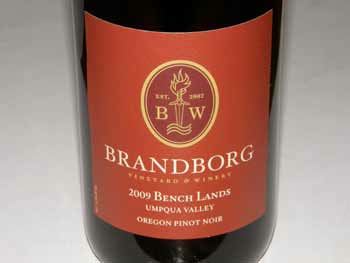
12.2% alc., 800 cases, $35. Winery’s flagship wine blended from several vineyards but primarily Brooks Estate. 100% de-stemmed, aged 18 months in 20% new French oak barrels of diverse cooperages. Light reddish-purple color in the glass. The nose offers shy aromas of dark red cherries, and oak-driven espresso. Elegant, relatively light and feminine, but offering a pleasing assortment of red and black berry fruits with a savory soul, wrapped in gentle tannins. Plenty of vim and vigor due to bright acidity which makes for refreshing drinking. A perfect food wine.
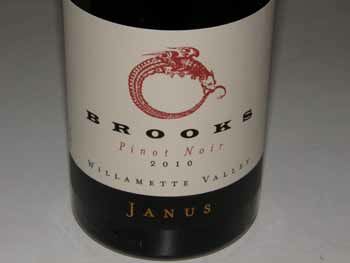
13.6% alc., pH 3.60, 125 cases, $35. A vineyard blend from Old School Vineyards and a select parcel from the Ribbon Ridge AVA. 100% de-stemmed, long and steady fermentation over 21-23 days. Aged in 60% new French oak barrels. Moderate dark reddish-purple color in the glass. Nicely perfumed with bright aromas of purple grapes, plum sauce, spice and custard. Richly concentrated flavors of boysenberry, black plum, white pepper and spice wrapped in tame, balanced tannins. Very seductive velvety mouth feel. A little more body and spice than the Old School bottling at this young age, but the Old School is more age worthy.
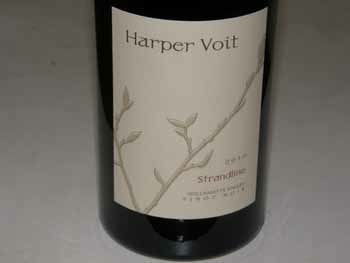
13.7% alc., pH 3.64, $35. Released May 31, 2012. Coury, Wädenswil, and Pommard clones planted across several decades (1971, 1979, 1984 and 1989). Volcanic Jory and Nekia soils. Harvest Brix 23.9º. Aged 18 months in 38% new French oak barrels from several cooperages. Medium reddish-purple color in the glass. Appealing aromas of black cherry, raspberry, spice, tea leaf and bramble lead to earth-kissed middleweight flavors of black cherries, black currents and plum. Commendable integration of oak. Plenty of mid palate sap with balanced tannins and a long finish. Very silky on the palate and easy to drink.
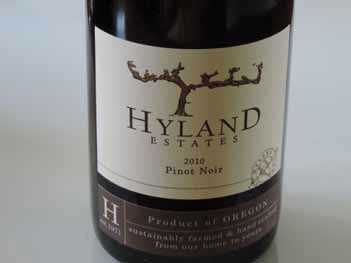
13.9% alc., pH 3.75, TA 0.50, $25. A product of NW Wine Co, vinified by Laurent Montalieu. Nekia series volcanic soils. Aged 6 months in 34% new French oak barrels. Moderately light reddish-purple color in the glass. Aromas of black cherries, briar and fennel lead to medium bodied flavors of black cherries, black raspberries and a generous cherry-driven finish. Good richness, soft tannins and well-integrated oak. An impressive offering at this modest price.
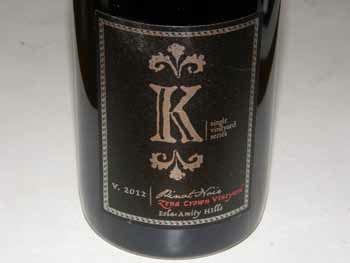
12.5% alc., 2,200 cases, $25, screwcap. Released December 15, 2012. · Light reddish-purple color in the glass. Darker fruits are featured on the nose including black cherries with a touch of spice and oak. Light and elegant, with satisfying cherry, blueberry and pomegranate flavors, finishing with an uplifting spiced cherry note. Gossamer tannins and every easy to drink. An impressive Willamette Valley blend. Buy this by the case for satisfying everyday drinking.
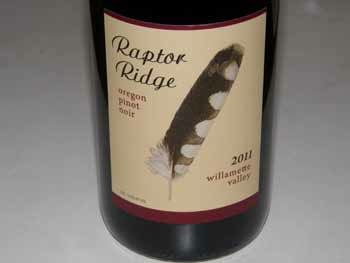
12.5% alc., 175 cases, $35. Willakenzie series sedimentary soils. Clones Pommard and 777. Aged in 29% new French oak barrels. Light ruby color in the glass. Delicate aromas of black cherries and dark red roses. Demure on the palate with plenty of finesse, featuring flavors of black cherries cloaked in fine-grain tannins, finishing with a pleasing, long kiss of cherries. Not a blockbuster, but a reflection of the vintage, well-crafted and thoroughly satisfying.
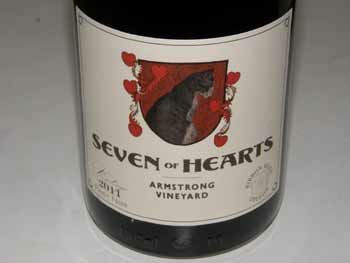
14.0% alc.,104 cases, $25. Crafted by Thomas Gerrie, the son of Cristom Winery (CrisTOM) owner Paul Gerrie and assistant winemaker at Cristom Vineyards. Stylistic similar to Cristom’s winemaker Steve Doerner. Second release. Equal parts blend of Cristom Eileen Illahe, and Feltz vineyards. Native yeast fermentation, 100% whole cluster, aged a minimum of 17 months in French oak. Unfined and unfiltered. Moderately light reddish color in the glass. Attractive scent of red cherry pie glaze, baking spice, toast and sandalwood. Lighter in weight than the 2009 version, but equally pleasurable, showing less whole cluster influence, and brighter acidity. Flavors of crisp red cherries and berries and spice backed by suave tannins. Delicate, even feminine in character, but offers a tasteful, seamless drinking experience.

2013 California & Oregon Chardonnay First Team All-Americans
12.8% alc., 136 cases, $42. This is no surprise as Brian has worked extensively with Chardonnay at Neyers Vineyards and Marcassin in the past. 60% of the fruit is from Bieze Vineyard which shares a fence with Seven Springs Vineyard. The balance of the blend is from the Wirtz Vineyard which dates to the early 1970s. Barrel fermented in mixed aged French oak barrels. Unfined and unfiltered and not cold stabilized. Label is adorned with bees courtesy of Clare and her hives. · Light straw color and clear in the glass. Brilliant aromas of fresh applesauce, the air after a rain, and graphite. Appealing flavors of baked apples, pear and lemony citrus. Slightly creamy on the palate with a refreshing lift of acidity on the finish. Not a showy or dolled-up wine, put pure and modest. One of the better Chardonnays I have had from Oregon. Bring on the oysters!
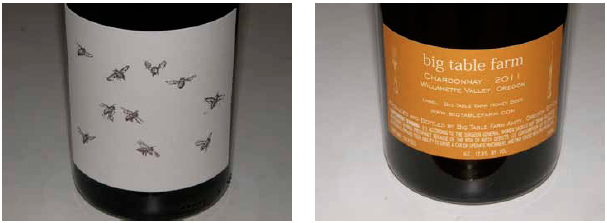
14.2% alc., 1,130 cases, $60. Released November 2012. Sourced from the renowned Ritchie Vineyard. Wente selection. Yield of 3 tons per acre from 38-year-old vines. Complete malolactic fermentation and 15 months aging in 50% new French oak barrels. · Light straw color and clear in the glass. Very expressive nose, offering aromas of lemon blossom, tangerine, croissant and almonds. Soft in the mouth, with plenty of pear, white peach and lemon flavor augmented by minerality. Faint toasty oak frames the wine which leaves a lingering impression on the finish. Did I mention the marvelous mouth feel?
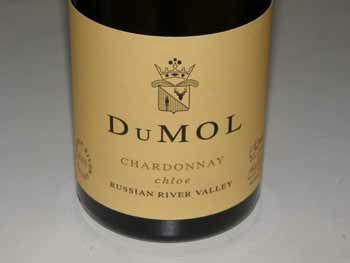
14.2% alc., pH 3.23, TA 0.74, 315 cases, $45. Release May 2013. Sourced from the Pellegrini Family’s Olivet Lane Vineyard that was originally planted in 1975 on the Santa Rosa Plain. This 65-acre vineyard was one of the first in the Russian River Valley planted to Pinot Noir and Chardonnay. The clone is Wente selection on AXR rootstock. The regular fog intrusion and well-drained clay loam soils are ideal for growing Chardonnay. Aged 7 months in 40% new French oak barrels. Inaugural release from this vineyard and what a winner! Light golden straw color and clear in the glass. Aromas of lemon, honey, pineapple and buttery oak lead to a delicious fruit-charged wine with a bevy of citrus, lemongrass and caramel flavors lifted by an hi-tone cut of acidity. A seductive creaminess adds to the appeal and the tonal finish perks up the palate for more. Quintessential Russian River Valley Chardonnay with a historical pedigree.
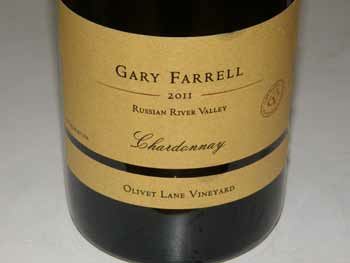
14.5% alc., pH 3.30, TA 0.69, 152 cases, $78. Bottled April 25, 2013. Inaugural release. From a vineyard planted in 1976. St. George rootstock and Hanzell clone selection massale from the original Ambassador’s 1953 Vineyard. Aged 18 months total with 12 months in 33% new French oak barrels. Moderate golden yellow color and clear in the glass. Reserved, but complex nose, offering aromas of lemon, grilled pineapple, baked apple and hazelnut. Very creamy and harmonious on the palate with the lemon and apple fruits draping the structure such that the wine feels sleek. More body and fullness than the estate bottling with added power on the finish. Remarkably silky on the finish as well, literally slipping off the back of the palate. Still superb when tasted from a previously opened and re-corked bottle two days later. This wine is still young and will benefit from a few years of cellaring to reach its apogee.

14.2% alc., pH 3.33, TA 0.63, 138 cases, $38. Sourced from replanted vines using cuttings from the original old vines including Wente clone. Ken has worked with this vineyard for more than 30 years. Whole cluster pressed, barrel fermented, 75% malolactic fermentation, aged sur lie 10 months in 17% new French oak barrels. Light golden yellow color and clear in the glass. I was enchanted with the nose that offered aromas of tropical fruits, pear, buttered brioche and slate. Delicious compliment of lemon, baked pear and apple flavors with the slightest hint of complimentary French oak. The wine really brings you to attention on entry and holds on for a satisfying, acid-driven finish. Very soft in the mouth and appealing now, but has the balance for a long life in the cellar.
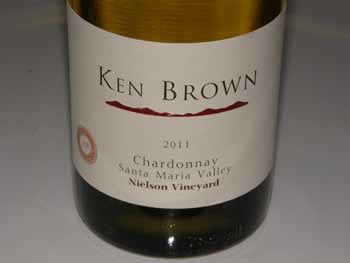
13.2% alc., $37. A high-elevation, old vine vineyard (almost 25-years-old) that ripens late even by late-ripening Anderson Valley standards. Old Wente clone. A very appealing wine that is not gussied up with oak and is highly flavorful. Lemon and green apple and citrus aromas and flavors are featured with a faint note of fresh brioche. Crisp, bright and refreshing, like biting into a ripe green apple. Very charming. This is a Grand Cru level old vine Chardonnay vineyard.
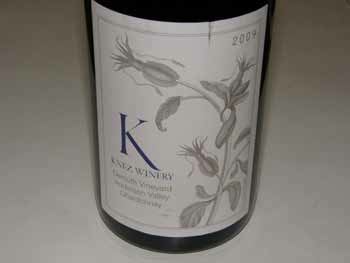
14.2% alc., 1,364 case, $58. Released October 2012. Fifteenth vintage from this vineyard first planted in 1981. This vineyard shines in both hot and cool years. Hyde-Wente selection planted exclusively for Patz & Hall on the best soils at Hyde Vineyard. Very well-drained sandy, clay loam which typically produces low vigor and low yields. Whole cluster pressed, indigenous yeast fermentations, aged sur lie with weekly stirring, 100% MLF in barrel, aged in 52% new Burgundian French oak barrels. Unfiltered. Light golden straw color and clear in the glass. Perfumey with attractive aromas of lemongrass, honey, pear and fresh air after a rain. Very classy, and of striking quality, with flavors of lemons, apples and oak-driven caramel and honey. Seamless, bone dry and done right. This is a wine that drinks so softly, you want to take another sip right away. Sublime seduction and one of California’s greatest Chardonnays.
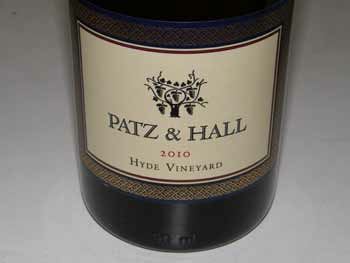
13.2% alc., $69. From 1.73 acres planted to Hyde, Wente and Dijon clones at 1,230 to 1,400 feet elevation. 24” of top soil over soft shale. Grapes are slowly whole cluster pressed for 4 hours. The must is settled overnight and barrels filled in morning. 20-25% new French oak barrels are used. The wine is left undisturbed in cask without stirring to complete native yeast fermentation that sometimes can take an entire year. Golden yellow color and clear in the glass. Appealing aromas of lemon peel, pineapple, slate and a hint of nutty, buttery oak. Delicious core of yellow apple and lemon flavors with a hint of butter brickle and oak. The fruit really pops in the mouth and hangs on for a very long and glorious finish. Juicy, crisp and thoroughly satisfying in every way. Yum. Held up beautifully in an opened and re-corked bottle finished over two days. One of the best California Chardonnays I have ever tasted.
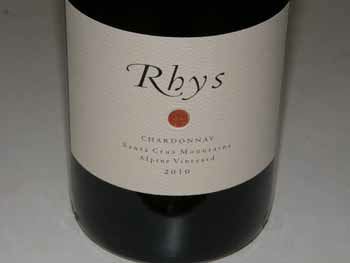
13.8% alc., pH 3.50, TA 0.60, 150cases, $40. First established in 1981, Hyde Vineyard is widely acclaimed. It is planted on gently rolling hills and cooled by wind and fog from nearby San Pablo Bay. The soils is well-drained ancient creek beds of clay loam and rocks. Clones are Wente Hyde Field selection and Robert Young hand harvested at 22.2º Brix just before the October rains. Whole cluster pressed, barrel fermented sur lie with regular stirring, 100% MLF, aged 11 months in 15% new French oak barrels and bottled unfined and unfiltered. Mild yellow blonde color in the glass. The aromas of nectarine, lemon, Fuji apple and hazelnuts draw you into the glass. A very polished and sophisticated wine offering refined flavors of lemon, pineapple, green apple, and brine with a pleasing kiss of lemon on the finish. The wine’s underlying bright acidity supplies plenty of vibrancy. This wine has a Burgundian soul and reminds me of a William Fevre Les Clos Chablis Grand Cru that I recently drank.

12.9% alc., pH 3.40, TA 0.60, 95 cases, $56. The Langley Hill is the large plot of estate Chardonnay (5.25 acres). It occupies a steep hillside at 1925 feet elevation, and is a very cool site. Loam, sandstone, shale and marine deposits in the soil. Harvest was the latest in the nearly 30 year history of Thomas Fogarty, picking well into November. Whole-cluster pressed followed by a cool barrel fermentation. Aged 18 months in 100% new French oak barrels. Light golden yellow and clear in the glass. I like oak with my Chardonnay and it adds just the right character in this wine. Aromas of grilled yellow peach, cashew butter, roasted almonds and ocean air. Delicious primary fruit flavors of peach, pear, and lemon, with secondary flavors of toasted brioche and honey, holding on with gleeful persistence on the finish. Very clean and uplifting with palate cleansing acidity and a brisk, satisfying ending. One of the best Chardonnays I have tasted in recent memory. My wife also went ga-ga over this wine and some have tabbed her the “Queen of Chardonnay.”
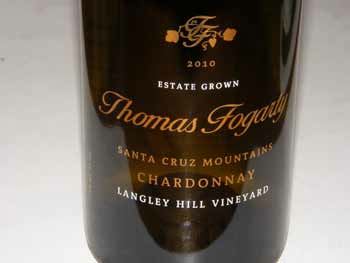
13.5% alc., pH 3.43, TA 0.69, 511 cases, $48. Sourced from Old Wente 1 Block, one of the oldest, coldest and windiest sections of Durell and Rocky Flat Block planted to Dijon 76. Fermented in concrete egg and oak barrels, aged in 60% new French oak barrels for 14 months. 100% malolactic fermentation. Moderate yellow-gold color and clear in the glass. Very nicely perfumed with aromas of lemon, pear, nori and the faintest oak. A delicious wine of elegance, class and sophistication featuring vivid flavors of lemon curd, lime, spice and toasty oak. Crisp and juicy, with excellent underlying mineral-driven acidity, finishing with length and lemon goodness. I am partial to barrel fermented, 100% malolactic fermented Chardonnay, and this wine delivers without being overwrought with oak-driven accents.
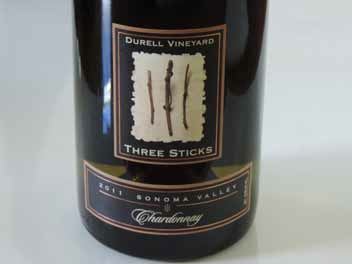
2013 California & Oregon Chardonnay Second Team All-Americans
14.5% alc., $43. From the dry-farmed Zio Tony Vineyard farmed by the Martinelli family. Located along Laguna Ridge at the edge of the Green Valley AVA. The vineyard was once an apple orchard, thus the name “La Pommeraie,” French for “the apple orchard.” High density plenty of Dijon 95 and Old Wente. Light straw color and clear in the glass. Moderately rich and very Russian River Valley in character, yet has enough restraint to appeal. Aromas and flavors of fresh apple, citrus, honey and brioche. Like biting into a juicy, ripe caramel apple on a stick. Beautifully balanced with just the right amount of oak.
13.9% alc., 955 cases, $60. Released November 2012. Sourced from Charles Heintz Vineyard, UCD 108. Yield 3.5 tons per acre from wines that are 29 years old. Complete malolactic fermentation and 15 months aging in 40% new French oak barrels. Light straw color and clear in the glass. Very fresh scent of lemon, grilled peach, pear and savory herbs. Remarkable palate presence with impressive energy and a vibrant lift of acidity on the extended finish. The peach, lemon and nutty flavors are complimented by a touch of caramelized oak and really grab your attention. Very flavorful, but has the balance and restraint to pair beautifully with food. Heintz Vineyard Chardonnay is my paramour.
13.5% alc., 450 cases, $40. A blend of two vineyards with the largest component from Keefer Ranch and a lesser amount from Heintz Vineyard (vines dating to 1982). Aged 14 months sur lies in 21% new and 79% 1, 2 and 3-year-old French oak barrels. · Light yellow color and clear in the glass. Aromas of lemon, apple and slate lead to crisp, vivid flavors of citrus, apple, white peach and oak. Plenty to like with forward fruit flavors reigned in by lively acidity, finishing on a high note with lemon-drop memories. Still fine the following day from a previously opened and re-corked bottle.
14.5% alc., pH 3.20, TA 0.72, 2,329 cases, $75. Cold, wet spring with rains causing a fair bit of shatter. Yields down over twenty percent. Summer temperatures were mild. Harvest extended from September 13 to 28. Select barrels were included in this final blend. Light straw color and clear in the glass. Nicely perfumed with aromas of lemon drop, peach, buttery brioche and chalk dust. The palate-staining flavors really pique your interest by their depth, offering notes of baked pear, green apple, grilled grapefruit and roasted nuts. Juicy and seductive with lively acidity, this wine is superb in every way. I rarely talk of finish in Chardonnay but this wine offers superb closing intensity and length. An outstanding wine that makes you want to clap.
12.5% alc., pH 3.36, TA 0.59, 142 cases, $33. Released November 2011. A winemaker selection of a blend of Dijon clones 76 and 95. Fermented with native yeasts in 50% new French oak with lees stirring, and aged 18 months where it underwent 100% MLF. The wine was bottle aged an additional 7 months before release. Minimal sulfite additions. Unfiltered.Pale straw color in the glass with slight cloudiness (bottled with lees). Attractive scent of lemon custard and buttered brioche. Fresh and frisky, with delicious flavors of lemon, pear, apple, pineapple and yeasty goodness, silky textured, finishing with a good cut of acidity. One of the more impressive Oregon Chardonnays I have sampled.
14.5% alc., pH 3.32, TA 0.62, 2,191 cases, $58. Sourced from six vineyards reflecting the Green Valley of the Russian River Valley appellation. Multiple clones. Named for Highway 116 (Gravenstein Highway) that cuts through the town of Sebastopol. Barrel and partially concrete egg fermented 15 months in 40% new French oak barrels. Moderate golden straw color and clear in the glass. Lovely aromas of honey, lemon curd, golden apple and butter brickle. Very beguiling on the palate with flavors of baked pear, apple, citrus, honey and caramel. Beautifully composed with bright acidity and good staying power on the finish. The best Chardonnay yet from Kosta Browne and a wine that competes with the top performers in the Russian River Valley.
13.5% alc.,pH 3.31, TA 0.70, 2,150 cases, $55. 100% MLF. Aged 13 months in 40% new and 60% two to three-year- old French oak puncheons and barrels. Light golden straw color and clear in the glass. A very embraceable wine with hi-spirited aromas of spiced apple, lemon, crème brûlée and vanilla cream, and sparkling flavors of lemon curd, green apple and a hint of pear. Oak is understated but supportive. Very juicy with lively acidity and a chalky, mineral blessed finish.
14.2% alc., $39. From the Pisoni family who are better known for Pinot Noir but their Chardonnays are first rate. Year in and year out, one of my favorite California Chardonnays (and well-priced too). Light straw color and clear in the glass. A perfect blend of fruit and oak-driven aromas and flavors featuring citrus, pear, crème brûlée, honey and caramel. Nothing stands out and the wine is in perfect focus, indicating impeccable winemaking. No quarter given to the French.
Chardonnay 14.5% alc., 100 cases, $65. Mostly Wente clone. 50% malolactic fermentation. Filtered. Aged in 75% new French oak barrels. Moderate golden yellow color and clear in the glass. Very aromatically enticing with scents of lemon curd, baked apple, and Acacia blossom. Bright and crisp on the palate, offering flavors of citrus, baked pear, and vanilla with an underlying sea-brine minerality. A big, flamboyant wine, yet beautifully balanced.
13.7% alc., 279 cases, $55. Released March 2013. Sourced from the 4-acre prized block that Hudson makes his own Chardonnay from. Planted in 1980, this block features Hudson-Wente selection isolated by Lee Hudson. Whole cluster pressed, indigenous yeast fermentation, sur lie aged with weekly stirring, aged in 55% new French oak barrels. Unfiltered. Light golden straw color and very slight haze (unfiltered) in the glass. A serious wine offering aromas of lemon, caramel, buttered popcorn and chalk dust. Elicits a Wow! on the palate with luscious flavors of lemon, baked pear, peach honey, toffee, and pastry creme. Ideal integration of oak, notable acidity and impeccable balance. One of California’s greatest and most sophisticated Chardonnays.
13.7% alc., pH 3.61, TA 0.78, $28. A blend of Sonoma Coast and Russian River Valley fruit. Aged sur lie 11 months in 100% French oak barrels. · Very light yellow and clear in the glass. Inviting array of tropical aromas including pineapple with hints of white peach and oak vanillin. Very enjoyable flavors of baked apple, grilled pineapple, lemon, lychee and slight burnt caramel finishing smoothly on a lemon drop note. Beautifully composed, thoroughly dry and refreshing. Tremendous value.
2013 California Chardonnay Value Priced All-AmericansAll wines were priced at or below $35 and received a rating of Very Good or above. 2011 Artesa Carneros Chardonnay 2011 Benovia Russian River Valley Chardonnay 2012 Briceland Vineyards Lolonis Vineyard Mendocino County Chardonnay 2011 Cambria Estate Winery Bench Break Vineyard Santa Maria Valley Chardonnay 2011 Hanzell “Sebella” Sonoma Valley Chardonnay 2011 J. Lohr October Night Arroyo Seco Monterey Chardonnay 2012 Joseph Jewell Russian River Valley Chardonnay 2011 McIntyre Vineyards Estate Santa Lucia Highlands Chardonnay 2010 Ten Acre Santa Lucia Highlands Chardonnay 2011 The Gardener Don Miguel Vineyard Russian River Valley Chardonnay 2011 Walt La Brisa Sonoma County Chardonnay
First Encounters of Noteworthy Pinot Noir Producers in 2013
Alouette Vinified by fifth generation Belle Glos Wines winemaker Joseph Wagner whose family founded Caymus Vineyards. Alouette is the French name for lark, a songbird that is a familiar sight in vineyards along the coast of California. A single, reasonably priced but excellent Sonoma County Pinot Noir is offered through retail distribution. Arnot-Roberts A boutique winery founded in 2001 by childhood friends Duncan Arnot Meyers and Nathan Lee Roberts. Nathan is a second generation cooper and builds all the French oak barrels for the winery. Total production is 2,000 cases of thirteen distinct wines allocated through a mailing list. Banshee Founded in 2009 by three friends, this winery focuses on Pinot Noir from West Sonoma County. Ross Cobb (Cobb Wines, Hirsch Vineyards) and Katy Wilson (LaRue) are consulting winemakers. Birichino A Santa Cruz-based winery founded in 2008 by winemakers Alex Krause and John Locke. The name is Italian for naughty or mischievous. Their flagship wines are a Malvasia and Grenache but a very good, inexpensive, non-oaked Pinot Noir was released from the 2011 vintage from vineyards in the southern Santa Cruz Mountains. Bravium Proprietor and winemaker Derek Rohiffs produces vineyard-designated and appellation-designated Pinot Noir and Chardonnay at a winery located on Treasure Island in the middle of San Francisco Bay. Quantities of Mendocino Ridge, Napa Carneros and Sonoma Carneros wines are very small and sold to mailing list members with select restaurant and retail placement. A portion of the profits from the sale of Bravium wines support Sip & Give. A rising star in the Pinot Noir kingdom.
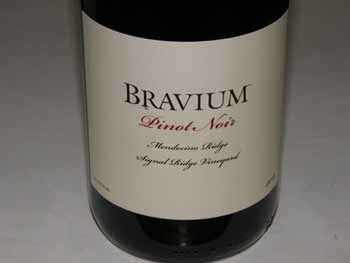 Bluxome Street Winery An urban winery on Bluxome Street in San Francisco’s SOMA district established in 2010. Pinot Noir is offered from sourced grapes (such as Weir Vineyard) and the winery’s own organically farmed Balinard Vineyard in the Russian River Valley. The winemaker is veteran Webster Marquez (Anthill Farms, C. Donatiello). The winery’s tasting room is open Tuesday through Sunday. The winery’s event space is used for special celebrations. CIRQ. Kosta Browne’s winemaker Michael Browne has launched his own personal label with the 2011 vintage. Two Pinot Noirs will be offered from two unique estate vineyards in west Sonoma County: Treehouse and Bootlegger’s. Highly allocated, mailing list only. See feature in Issue 34. Coterie Cellars An urban winery located south of downtown San Jose, California owned by a husband-and-wife team of Kyle and Shala Loudon. Pinot Noir is produced from prestigious vineyards in the Russian River Valley and Santa Lucia Highlands. The wines are sold through a mailing list and the winery’s online store. Cutruzzola Vineyards Dr. Francis Cutruzzola owns a small vineyard seven miles east of the town of Cambria on California’s Central Coast. Less than 100 cases of Gloria Estate Pinot Noir are produced under the guidance of winemaker Stephen Dooley of Stephen Ross Wine Cellars. Deux Punx A partnership between Dan Schaaf and Aaron Olson who are the two “punx” behind this label. A Pinot Noir from Elk Prairie Vineyard in Humboldt County is offered through the winery’s website store. Domaine de la Côte Winemaker Sashi Moorman, sommelier Rajat Parr, and their business partners bought Evening Land Vineyards’ 40 acres of vineyards in the Sta. Rita Hills. The Pinot Noir is crafted with whole cluster fermentation and ambient yeast. The four vineyards are four miles from the ocean and planted in a soil known as diatomaceous earth that is unique to a small section of the Sta. Rita Hills.
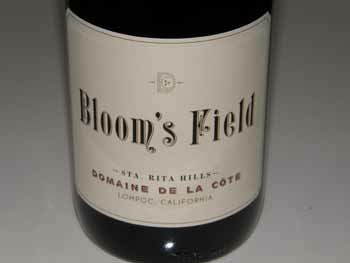 Easkoot Cellars Emily Weissman and Stephan Schindler of online retailer Winemonger produced Pinot Noir from Corda Vineyard in Marin County and Keller Estate in the Sonoma Coast in 2011. Suacci Vineyard was added as a vineyard source in 2012. The name of the label is that of Alfred Derby Easkoot, Marin County’s first land surveyor. The winemaker is Matt Duffy of Vinify. Hilliard Bruce Vineyards A beautiful 21-acre estate vineyard that was planted in 2004 to Pinot Noir and Chardonnay in the Sta. Rita Hills. Newer plantings are ongoing. The vineyard is meticulously farmed by owner John Hilliard and noted viticulturist Jeff Newton. The first estate Pinot Noir was offered in the 2008 vintage. A LEED certified winery will be completed in time for the 2014 harvest. The owners are managing the winemaking with the assistance of consultants that have included Paul Lato (Paul Lato Wines) and Peter Work (Ampelos). LaMontagne Winery Vintner Kimberly Smith was mentored by Clos Pepe’s Wes Hagen and launched her own label with the 2011 vintage. Limited production vineyard-designated Pinot Noirs from Santa Barbara County sources. A tasting room is open in the Lompoc Wine Ghetto. Mansfield-Dunne A small winegrower in the Santa Lucia Highlands that started a new label with the 2011 vintage. The single Pinot Noir comes entirely from the family owned estate Peterson Vineyard. The winemaker is veteran Ed Kurtzman (Sandler Wines, ROAR, Freeman Vineyards & Winery). A second vineyard is under development in the Santa Lucia Highlands. Onward Wines Winemaker Faith Armstrong-Foster sources grapes from Cerise Vineyard in Anderson Valley and Hawkeye Ranch in Redwood Valley for her vineyard-designated Pinot Noirs. Faith is a graduate of University of California at Davis and her spouse, Sean Foster, is the Senior Winemaker at Merryvale Vineyards. The wines are sold through a mailing list. Ousterhaus Wine & Vineyard A boutique winery in the Alexander Valley offering two Pinot Noir Rosés from the 2012 vintage. Grapes are sourced from two vineyards in the Russian River Valley. The winemaker is Micah Wirth (Joseph Jewell). Pence Ranch Pinot Noir from the estate Pence Ranch Vineyard located just outside the far eastern portion of the Sta. Rita Hills AVA so the wines are labeled Santa Barbara County. About 40 acres are planted on the 200- acre property primarily to heritage and Dijon clones of Pinot Noir. The winemaker is veteran Jeff Fink, formerly of Tantara. Four Pinot Noirs were released from the estate vineyard in 2010 and were stellar. The wines are offered through a mailing list. Reuling Vineyard Jim and Jackie Reuling own a 14.4-acre Pinot Noir vineyard in Forestville in the Sonoma Coast AVA. The vineyard was planted in 2003 in conjunction with Peter Michael Winery and were the source of Peter Michael’s La Caprice Pinot Noir in 2007 and 2008. Subsequently the grapes were sourced by Aubert. The first Reuling Vineyard Pinot Noir, vinified by winemaker and vineyard manager Matt Taylor, was released from the 2011 vintage. A Reuling Vineyard Chardonnay is planned for the 2014 vintage. The wines are sold through a mailing list.
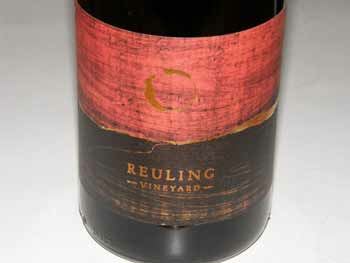 Rocking K Vineyard A single vineyard Pinot Noir produced from a small Sonoma Carneros vineyard planted in 1997 to Pommard clone. Bobby and Char Kiel bought the vineyard estate in 2010. The first vintage in 2010 was crafted by Scott Rich (Talisman) and the subsequent vintages by Michael Peters (Kasuari Wines). Scratch A project of Wrath and Kori winemaker Sabrine Rodems producing small lots of Riesling, Grenache and Pinot Noir from the Arroyo Seco and Santa Lucia Highlands AVAs. Sabrine launched her label in 2011. A Pinot Noir is offered from Kirk Williams Ranch in the Santa Lucia Highlands and sold through a mailing list. Skywalker Vineyards A small production winery located at George Lucas’s Skywalker Ranch in Marin County. 2007 was the first vintage of Skywalker Vineyards Pinot Noir. The winemaker is Scott McLeod, the former Director of Winemaking for Francis and Eleanor Coppola. The Skywalker Marin County Estate Pinot Noir, Rosé and Chardonnay are sold through a mailing list. Soliste Cellars See “Winery of the Year.” Ten Acre Winery Scott and Lynn Adams, who have grown wine grapes for almost twenty years, established Ten Acre to produce Pinot Noir and Chardonnay from vineyards in the cooler reaches of the Russian River Valley and the Sonoma Coast. Ten Acre’s vineyard program is guided by renowned vineyard manager Charlie Chenoweth. The winemaker is Michael Zardo who has been the assistant winemaker at Pisoni Vineyards & Winery. The wines are available for tasting at Bella Vineyards & Wine Caves in Healdsburg and are sold primarily through a mailing list. The Gardener Husband and wife team Chris Condos and Suzanne Hagins produce a line of varietals from organic grapes including a Carneros Pinot Noir. Chris launched Vinum Cellars in 1997 and has been the consulting winemaker for Kathryn Kennedy Winery since 1998. Together with Suzanne, they started the Horse & Plow label in 2008. Suzanne has worked at De Loach, David Bruce and Goldeneye wineries and had a small Pinot Noir label, Lutea, before starting The Gardener label along side Horse & Plow. The Gardener label offers a Carneros Pinot Noir and Russian River Valley Chardonnay that are outstanding, yet reasonably priced. Tin Barn Vineyards Tin Barn is a specialist in single vineyard wines from Sonoma County. The name of the winery derives from Tin Barn Road that winds along the remote Sonoma Coast to the source of the debut wine, and the fact that the winery is housed in a “tin barn” warehouse in rural Sonoma. The winemaker and co-owner is Michael Lancaster, a graduate of the University of California at Davis enology program. He acquired winemaking experience at Quail Ridge Cellars and Gloria Ferrer Champagne Cellars before forming a partnership with friends and launching Tin Barn Vineyards in 2000 in a collective known as Eighth Street Wineries in Sonoma. Vino Vargas A collection of wines crafted by a team of artisans that includes the Rio Ruso Russian River Valley Pinot Noir vinified by winemaker Pedro Vargas, a University of California at Davis graduate.
Coattails Winery Jared and Mikey Etzel, the two sons of Beaux Freres winemaker and co-owner Mike Etzel, produce small lots of Pinot Noir. The first vintage was 2007. Both Jared and Mikey completed the Oregon State University Enology and Viticulture Program. The wines are sold through a mailing list and the winery’s online store. Denison Cellars Winemaker Tim Wilson was educated at California State University Fresno and learned his craft at Chateau Ste. Michelle, Edna Valley Vineyard, Benton-Lane Winery and Dobbes Family Estate. In 2009 he launched his own label focusing on Pinot Noir from small, sustainably-farmed vineyards. Tasting is available in Carlton at Republic of Jam and in McMinnville at Biggio Hamina Cellars. Mouton Noir Founded by sommelier André Hueston Mack in 2007, the wines were initially created for some of New York’s best restaurants. The wines offer clever, appropriately irreverent names and cheeky matching slogans. One of the winery’s bylines is “Kick-Ass Garage Wines from Oregogne.” 20,000 cases are produced of several varietals as well as a line of wine-themed swag.
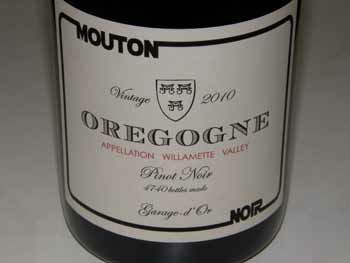 Thomas Gerrie 100% whole cluster Pinot Noir crafted by Thomas Gerrie, the son of Cristom Vineyards owner Paul Gerrie, who is the current assistant winemaker at Cristom Vineyards. Very small production Pinot Noir in 2009 and 2010 priced at $25 and gobbled up by those clued-in. Wahle Vineyards & Cellars Mark Wahle, M.D., produces Pinot Noir from two estate vineyards: the home estate vineyard in the Yamhill-Carlton District first planted in 1974 and one of Oregon’s oldest vineyards, and Holmes Hill Vineyard in the Eola-Amity Hills. While still practicing emergency medicine in Portland, he manages to produce 1000+ cases of estate Pinot Noir. Walnut City WineWorks A unique custom crush facility established in 1999 that not only assists clients in producing wine, but also plants, manages and farms vineyard sites. The brands include Walnut City WineWorks, Bernard Machado, Carlton Hill, Z’IVO, Genius Loci, Lundeen and Robinson Reserve.
Soliste: The PinotFile Winery of the Year
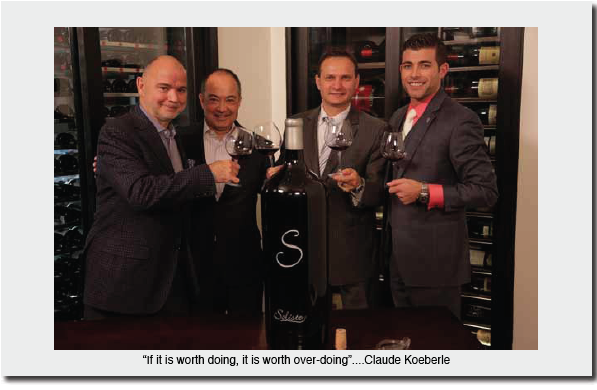 Claude Koeberle and Don Plumley couldn’t have more dissimilar backgrounds, yet their fortuitous meeting led to a subsequent winery partnership that in less than ten years has become one of California’s most avant-garde wineries. It wasn’t wine that brought them together, but rather two dogs, Chip and Gabby (more about that later). Claude hails from Burgundy where he was born into a family whose tradition in the wine industry dates back decades. The family both owned vineyards and made wine. As a youngster, Claude hung out with many of Burgundy’s greatest vignerons including Henri Jayer, who joined the family table at Claude’s home. Although he achieved remarkable success as a chef, he never lost his passion for wine, and Pinot Noir in particular. Don did not have the good fortune to grow up in a family with wine on the dinner table. The idea of a career in the wine industry was never on his radar as he successfully pursued a career in sales and marketing, strategy consulting, and the language translation industry. His first memorable wine, a Chablis, was savored as an adult while in Nice on a sunny afternoon overlooking the Mediterranean. Claude’s father, Paul Koeberle, was a very famous French pastry chef and Claude was always around noted chefs as a youngster. He began his first restaurant apprenticeship under Paul Bocuse and subsequently apprenticed under Alain Chapel, a Michelin 3-starred chef who Claude revered, and who is credited with being one of the originators of Nouvelle Cuisine. While an apprentice, Claude would frequently leave the restaurant to work in the vineyards at harvest alongside great winemakers, and began to understand the similarities between cooking and winemaking. Claude has remarked, “Nouvelle Cuisine began when the chef assumed control and started putting food on the plate. This was analogous to great wine production when the winemaker controlled what went on in the vineyard. Whether it is food or wine, it is all about the ingredients.” It was Chapel who was to inspire Claude in his future endeavors, encourage his drive for perfection, as well as mold his madness when he told him, “Everyone remembers the best and the worst, but nobody remembers mediocrity.” Claude was to use this inspiration to become the youngest 3-star Michelin Chef in Paris at La Vivarois. A love affair led Claude to New York City where he was a catering chef for many of the city’s important people. He was then drawn to Southern California where he cooked at Ma Maison, L’Orangerie, Les Anges, Tamayo, Opera and Tapenade. A James Beard Award winner as a Master Chef, Claude is currently a partner in several restaurants including Bouchon and San Francisco’s Frances. Along with his chef spouse, Elisabeth, he is the driving force behind Creative Culinary Concepts, Inc. and K World Cuisine, Inc., both based in Newport Beach, California. Don was born and raised in Southern California to a Japanese mother and American father. He was a high achiever, the third youngest in the nation to obtain the Eagle Scout level, and was accepted to medical school after an undergraduate degree at University of California at Davis (he deferred his acceptance and ultimately never attended medical school). He married his college sweetheart, Beth, had a son and daughter, and later graduated with an MBA from UCLA with an eye to international business. A global job for a language translation company led to constant overseas travel and many business meals at great restaurants where he learned to navigate wine lists. While living in Irvine, California, Don was to meet Claude through a stroke of luck because of the family dog, Chip. Chip became friends with a neighbor dog named Gabby, who happened to be leashed to Elisabeth Koeberle, a neighbor in Irvine. Beth and Elisabeth became friends, and so the Plumleys did what they always did for new friends, they invited them to their house for dinner. They had no clue as to their cooking credentials. What they cooked or even drank is a distant memory, but the Koeberles reciprocated and Don realized the Koeberles were in a different food orbit. The friendship was cemented one evening when Don cooked his “famous” fire pit paella and Claude was weeping in his dish. Don was mortified and thought, “What have I done?” Claude said, “It is sooooo good.” A lifelong friendship bound by food was born. Claude began to share his extensive wine cellar with Don and showed him a side of the wine list he had never experienced. Don fell deeply in love with Burgundy, and Claude was a willing enabler. Don had an opportunity to direct a manufacturing company in Petaluma and this tore the Plumleys away from their dear friends Claude and Elisabeth. It was then that another stroke of fate enabled Soliste. The Plumleys settled in Petaluma near Beth’s sister and spouse who had become serious wine fans and established Sonatera Vineyard near Sebastopol in the Sonoma Coast appellation. In 2005, during a break in careers, Don took a bottle of wine made from Sonatera Vineyard fruit to Claude and they shared the bottle in Claude’s backyard. Claude sipped and remarked, “It’s not my style, but there’s some pretty interesting stuff in there.” Don replied, “There’s a block available, we can make it our way. You are always complaining about California wine, so here is a chance to do what you want.” Claude had never considered owning a winery or making wine, but he quickly agreed to their partnership and that’s how Soliste Cellars was born.
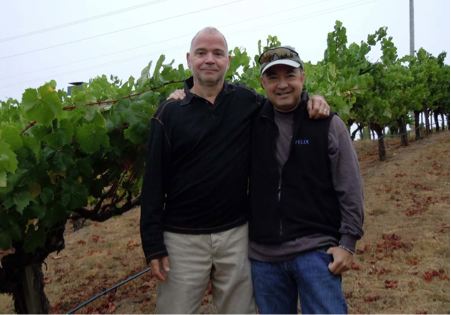 The name Soliste is derived from the special barrel or “soliste” that Burgundian winemakers reserve for their family and friends. The first vintage was 2005 and consisted of 130 cases of Sonatera Vineyard Pinot Noir. It was intended primarily for cronies and family, but sommeliers loved it and restaurants snapped it up. The following vintage consisted of 650 cases and was sold primarily to restaurants. Young winemaker Ryan Zapaltas (Zepaltas Wines, Siduri Wines) joined the team with the 2007 vintage and production was slowly increased. The plan was to stay small, focus on selected restaurants with the promise that the restaurant clients would never run out of wine. The project was costly but only tenable because the partners retained their professional jobs. Because it was two dogs who brought Claude and Don together and led to the founding of Soliste, the corks from Soliste wines display two paws, one on each end. The goals at Soliste soon became clearly defined and characterized by focus and conviction. There would be no compromise in quality with all farming and winemaking decisions based on what went into the bottle rather than financial considerations. Claude says, “We thought that if we did everything right there was not much financial risk.” The word commitment comes up frequently in conversations with Claude. He professes a dedication to Old World beliefs and traditions, applying them to produce California wines that not only have finesse and balance that work in harmony with fine cuisine, but can compete with the best on the world stage. Claude is a staunch believer that Sonoma County has the finest fruit in the world, but it is often abused in the sense that it is picked too ripe and vinified with too much extraction and oak, resulting in wines that are monotone in character and lacking in identity. This fanatical commitment to quality reaches its ultimate expression in the MonoClone® Pinot Noir program launched with the 2009 vintage. The belief at Soliste was that blending clones, different vineyards, and various cooperages homogenized the aromas and flavors of Pinot Noir. Instead, all Soliste Pinot Noirs consist of a single clone, married with a specific site, climate and exposure, and then aged individually in a single cooperage. Claude remarks, “We believe that a wine from a single clone from a single site is the most expressive wine from that site.” For example, the Sonatera Vineyard has three different hillside exposures and several different clones. A blend tends to diminish what each clone brings to the finished vineyard-designated wine. Claude understands that using a single clone implies a higher risk because there is no blending option. Single clone Pinot Noir is often criticized as lacking in some component such that it is not a complete wine. Claude would argue that it boils down to site, particularly with a clone like “828.” The clone must be matched perfectly to site for the purest and fullest expression of a Pinot Noir clone. The use of different coopers also homogenizes a wine by bringing disparate seasoning aromas and flavors to the wine. At Sonatera, the wines will ultimately be aged in new (usually only 20%), 1-year, 2-year, and 3-yearold oak barrels all the same type and specifically tailored for each wine. Such a strict oak regimen is more costly, especially since the preferred barrels are very expensive. Claude’s upbringing and his background as a chef has led him to a unique approach to crafting his wines. His background in Burgundy gives him an understanding of terroir and he appreciates that 90% of the success in making wine is attributable to the work in the vineyard. He is a strong proponent of either owning or directing the farming of his grape sources. His contacts in wine allow him to talk with some of the world’s greatest European winemakers who advise him on a personal and informative level. He has studied barrels in detail, appreciative that wine spends more time in barrel that in the vinification process per se. Claude has done research in both Burgundy and stateside to discover the single best oak barrel most suited to each wine he produces. He also understands that oak is a desirable seasoning for Pinot Noir, but should never be a prominent feature. The analogy in cooking would be adding salt as a seasoning to enhance flavor with the preferable aim that the resulting dish have no detectable salt flavor. Since the first Soliste vintage in 2005, the use of new oak has been reduced by 50%. Claude’s philosophy is well summarized on the Soliste website. “We are particularly inspired by winemakers who have challenged the status quo to elevate their region or cépage to grand cru level. Central to our philosophy is to be bold, experimental, and take risks; not arbitrarily, but with intent, diligence, and a long term vision.” He invokes the rebellious voice of the Master of St. Andelain, the self-taught iconoclast Didier Dagueneau, “If you want to be the best, you need the methods and techniques to get you there. Your vines must bear the best grapes; your vinification must be the most rigorous. There are no recipes. It’s all in the details of viticulture and all the details of winemaking, the assemblage of little things, 100 details and commitments which makes for the minute differences between a good wine and a great one.” Claude is obsessed and infatuated with Burgundies and is not shy when setting expectations that his Pinot Noirs show similarities to the great wines of Burgundy, even the one with the three-letter acronym. The four MonoClone® Pinot Noirs produced since the 2010 vintage are sourced from Sonatera Vineyard, Keller Estate (located in the Petaluma Gap region of the Sonoma Coast), and Guidicci Vineyard (located on Vintner Road near Occidental), all in the Sonoma Coast appellation. The Forêt is 100% Clone 23 (Mariafeld) and the L’Ambroise 100% clone “828” are sourced from the Guidicci Vineyard. The L’Espérance is 100% clone 115 and sourced from Sonatera Vineyard, and the Nouveau Monde is 100%Pommard clone from Keller Estate. It is of interest to discuss each wine individually. L’Ambroisie This wine was first produced from the 2010 vintage. The Guidicci Vineyard is a gorgeous vineyard site situated on a steep slope in the middle of a redwood forest. The “828” clone planted here is neither Dijon 828 nor a true clone but a selection brought to the U.S. from France by Gary Andrus with its true origin still shrouded in mystery. The site is crucial with the “828” selection because wines made from 100% “828” can be spectacular or insignificant. Only 29 cases (1 barrel) was made in 2011. Forêt The reclusive Mariafeld clone, UCD 23, has rarely appeared as a single clone, vineyard-designated offering. This clone was brought into the United States from the government research station in Wädenswil, Switzerland in 1966. Like “828,” it is a very site-specific clone and is more widespread in Oregon than California. Typically, the clone shows brilliant red and black cherry and berry fruit with notable Christmas spice and plenty of backbone. Claude likens this wine to those of Vosne-Romanee. Nouveau Monde This wine marries the virtues of Volnay and Pommard and is likened to a Côte de Beaune classic. It displays the synergy between the fresh crystalline acidity of Volnay and the abundant yet fine tannins of Pommard. 149 cases produced in 2010. L’Espérance For the partners at Soliste, L’Espérance is their benchmark, the wine that sets the tone and embodies all the challenges, determination and sacrifice that comes with crafting compelling Pinot Noir. Very Chambollesque, this wine is always the most sought after Soliste release. Only 49 cases produced in the 2010 vintage. The greatest California Pinot Noir I tasted in 2013 was the 2009 Soliste L’Espérance enjoyed one day at a lunch and generously shared by Claude, now long since sold out (49 cases produced), and only a lasting memory.
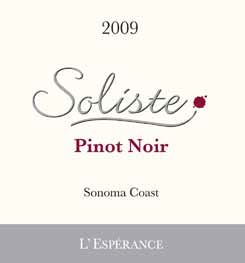 Other Soliste varietals that I have samples have also been memorable. 2010 L’Age D’Or Russian River Valley Chardonnay Claude has long refused to acknowledge that California makes Chardonnay and never considered an attempt to produce it. He has said, “They are not wines, they are replacements for cocktails. They are like buttery popcorn soaked in oak trees.” When Don suggested they make Chardonnay, Claude intoned, “Over my dead body.” He felt that if they could not make it lean and elegant with great acidity and balance, they should not even try. He told Don, “Come and try this Montrachet with me and let the urge pass.” Don’s continued pestering eventually led to Claude’s agreement to make Chardonnay with him in the Soliste style. The partners planned a three-year commitment using the Rued selection of Chardonnay from the established Lynmar Quail Ridge Vineyard in the Russian River Valley, and undertook trials with various vinification techniques including the use of imported Nomblot concrete eggs from Burgundy and 600L thick-stave oak barrels from Taransaud. It was an expensive experiment to say the least. The wine aged in concrete was called Les Cailles and it was hoped that it would have more minerality. The other wine was aged in French oak for 16 months and called L’Age D’Or. Today, Les Cailles is closed in and stays in the cellars until it is ready, but there is no guarantee it will ever reach that point or be released. Claude is not a fan of concrete eggs. Claude has a vision for each of his wines using what he considers the French pinnacle of that varietal as a comparison. For Chardonnay the benchmarks are Domaine Francois Raveneau Les Clos Grand Cru Chablis and Francois & Antoine Jobard Meursault 1er Cru Blagny. The Soliste wine has the minerality, elegance and acidity of those white Burgundies, yet the apple tarte tatin, lemon curd and quince flavors that reveal its Russian River Valley DNA. 340 cases were released on allocation ($50).
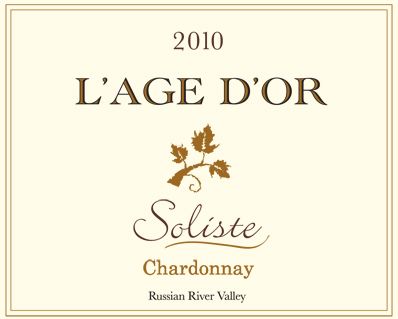 2011 and 2012 Lune et Soleil Lake County Sauvignon Blanc This and the St Andelain Sauvignon Blanc are inspired by the late Didier Dagueneau. Crafted from a single organic estate vineyard using 100% whole cluster pressing and aged in 600 liter barriques of special thick staves to minimize oxygen transfer, malolactic fermentation is avoided to preserve acidity and length. The 2011 (396 cases, $25) is sold out. The 2012 (392 cases, $25) is in limited release. 2010 and 2011 St Andelain Lake County Sauvignon Blanc Didier Dagueneau revolutionized Sauvignon Blanc and brought it to grand cru status equal to that of any great white Burgundy. He was an iconoclast among vignerons with no formal winemaking training, but because he was infatuated with great Burgundies, he brought Burgundian winemaking methods that were uncommonly employed to Pouilly-Fumé. He severely pruned for low yields, hand harvested fruit over several successive passes through his vineyards, used vineyard-designate bottling, skin contact and barrel fermentation. He also created his own barrels, the most famous being a cigar shape barrel that Soliste has adopted to craft St Andelain. This wine is from a single estate organically farmed vineyard. After harvesting, the grapes are de-stemmed, allowed 24 hours of skin contact, barrel fermented and aged 16 months in a cigar shape barrel. There is no malolactic fermentation to preserve acidity and length. 2010 (123 cases, $55) and 2011 (223 cases, $55) are available by allocation. Noted Sommelier, Aldo Sohm, of New York City’s Le Bernardin restaurant said about the 2011 wine: “This is the greatest white wine I have ever tasted, anyplace, anytime.” I have tasted this wine on three occasions and agree wholeheartedly that it is the greatest Sauvignon Blanc short of Dagueneau’s wines I have ever tasted. A true tour de force.
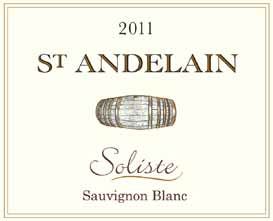 2008-2012 Soleil Sonoma Coast Rouge Rosé de Pinot Noir The first year of this wine, 2008, consisting of 65 cases, sold out immediately. In 2012, production increased to 327 cases ($22) and is in limited release. The Rosé is “Le Vin des Amis,” a fresh, crisp, and aromatic wine that Claude calls a “happy wine that reminds one of summer.” Claude told me the best match for this wine is sushi (“an incredible pairing”), although charcuterie and paella pair beautifully as well.
 Narcisse Sonoma Coast Pinot Noir You won’t find this wine for sale on the website since the entire production is allocated to restaurants for by-the-glass and bottle programs. It is priced at about half of Soliste’s other Pinot Noirs and is very popular. Made in a more fleshy California style and representing a blend of vineyards, 600 cases were produced in 2012. Claude believes that a winery’s entry offering should not be an afterthought, but be representative of the winery’s vision and quality. For example, many wineries choose their best barrels for reserve and vineyard-designated wine programs by tasting from barrel before bottling. They then blend the wines in stainless steel tanks and bottled them quickly. In the case of Narcisse, the blend spends another 8 months in barrel to allow the blend to integrate and optimize its character before it is released. Winemaking at Soliste is thoughtful and obsessive. Because a vineyard never gives you even ripeness at harvest, and since some whole cluster is preferable in the fermentation, multiple passes are made in the vineyard, an expensive proposition. Claude points out that cold maceration was invented by Henri Jayer because vintages of his time were very cold and a cold soak was necessary to extract concentration and flavor. Applying cold soaks automatically here in California is an anachronism to Claude so he adjusts the use of this winemaking technique to fit the vintage and the site. The very small production Soliste wines are allocated through a mailing list: www.soliste.com. The majority of the wine is sold to fine dining partners throughout the United States ( a list is posted on the winery’s website). Soliste wines are a favorite among sommeliers and you will find the wines in practically every noteworthy Michelin-recognized restaurant in America. Consumers have come across Soliste wines through word of mouth and fortunately, beginning with the higher yielding 2012 vintage, a little more wine can be allocated to wine lovers. Claude believes the wines will age marvelously, reaching their apogee in 5 to 7 years. The consumer should consider cellaring their purchased wines while drinking the wines at restaurants which are offered at a younger stage. Claude is a big fan of magnums (his grandfather was nicknamed “magnum” because he only drank Krug out of magnums) and a substantial amount of magnums will be available for the first time from the 2012 vintage. Don manages the logistics and sales so he is the one to deal with regarding inquires at don@soliste.com, and Claude is the one to exchange experiences and tasting notes with (he would love to hear from you) at claude@soliste.com. I have had the pleasure of dining with Claude on a few occasions and he is truly, in Don’s words, a “force of nature.” His partner, Don, has this to say about him in the winery’s newsletter. “If you found yourself together with him at a long dinner with endless wine, great food and compelling conversation, you would stumble out, quite fuzzy, but clear on a few things including asking yourself, when is the next one! Claude is as generous sharing his opinions as he is sharing his cellar. His strongest, indelible, Gallic opinion, just bordering on religious fervor is that Cabernet is an ‘evil weed’ and that Bordeaux wines are for trophy hunters.” (Claude has only stepped foot in Bordeaux once and that was to visit D’Yquem to fill out a vertical of magnums he inherited from his family) Claude is completely infatuated with Pinot Noir and specifically Burgundies, and waxes poetically about how Pinot Noir brings emotion, even a sexual relationship to the table, offering multiple layers of affect and a mesmerizing nose of truffles, sous-bois (forest floor), spiced plum and wild cherry. He relishes the conversation that Pinot Noir brings to the dining table, and speaking from a chef’s perspective, how Pinot Noir has no limit to what food it can match to, from elegant to rustic cuisines. He notes, “It is a wine made for the table experience.”
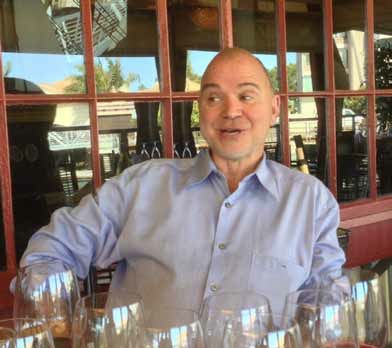 The future is bright for Soliste because the project is a lifetime experiment. Pinot Noir humbles you, and Claude says, “The more you know the less you know.” To further refine and perfect the wines, Soliste continues to search for ideal 8 to 14-acre vineyard sources, preferably estate owned, and thoughts of having a winery where all wines can be vinified using 100% native yeast (Soliste wines are currently produced at a custom crush facility, Vinify, in Santa Rosa where this cannot be accomplished). Staying small, precise and focused to make the best wine from an individual site is the Soliste mantra. Note: the initial photo in this feature was taken at A Voce restaurant in New York City where 7 18-liter bottles (each bottle contains 2 cases) of 2009 Sonatera Pinot Noir were opened nightly over 7 days. This photo was taken at the time of the first taste of the first bottle. Left to right, Claude, Don, Olivier Flosse, Wine & Beverage Director, and Zack Kameron, Head Sommelier. Here is another photo showing the 7 bottle lineup:
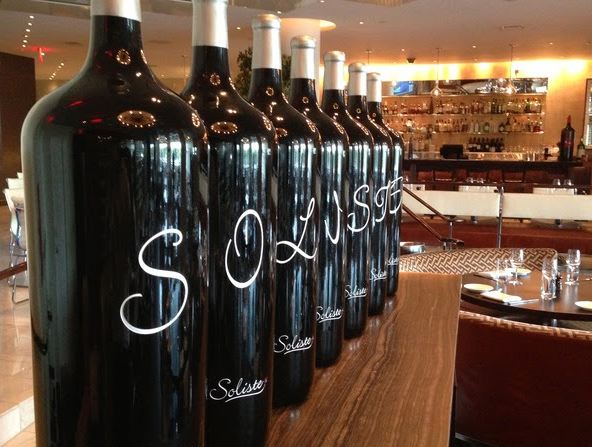 I have tasted some of the 2009, and nearly all the 2010, 2011 and 2012 Soliste releases but have only formally reviewed the following. Trust me, all the wines are superb. When you drink Soliste wines with Claude, his charisma leads you on a religious path of devotion to his wines. However, I have experienced enough of the Soliste wines apart from Claude to know that they are really enticing.
2012 Soliste Soleil Sonoma Coast Rouge Rosé de Pinot Noir 13.1% alc., 327 cases, $22. · Moderately light pink coral color in the glass. Aromas of dried cherries, alpine strawberries, melon and herbs. Fresh flavors of strawberry, pink grapefruit and orange zest, finishing with a note of tart grapefruit peel. Dry and easy to like, with a freshness that is the calling card for fine Rosê. Score: 89
2010 Soliste L’Ambroisie Sonoma Coast Pinot Noir 12.8% alc., 23 cases, $100 (sold out). Clone “828” from Guidicci Vineyrd near Occidental. · Moderate reddish-purple color in the glass. Red fruits are featured in the nose and on the palate. An acid-driven wine that is somewhat austere with flavors of red cherry and cranberry, finishing with a cleansing riff of citrus. A very pretty, elegant wine with gossamer tannins. If the Forêt is akin to a leather jacket, this wine is more like a silk shirt. Score: 89
2010 Soliste Forêt Sonoma Coast Pinot Noir 14.1% alc., 149 cases, $85. Clone 23 (Mariafeld) from Guidicci Vineyard near Occidental. · Medium reddish-purple color in the glass. Very clean, bright and fresh aromas of black cherries and potpourri. The wine delivers a delicious mouthful of dark berry and black cherry fruits, expanding on the palate with nuance and class, finishing with a statement. A subtle cola and earthy accent adds interest. Juicy, with soft tannins. When tasted a day after opening and re-corked, the wine was still pumping out Pinot goodness. Score: 95
2011 Soliste L’Ambroisie Sonoma Coast Pinot Noir 12.8% alc., 29 cases, $100. 100% clone ”828” from Guidicci Vineyard (MonoClone®). One site, one clone, one cooperage. Rigorous cluster selection, very low yields, 30% whole cluster, aged 16 months in 20% new French oak barrels. · Moderately light reddish-purple color in the glass. This is a wine that benefits greatly from decanting now. Wonderful aromas of black cherries, forest floor and spice. Layered flavors of black cherries, plums and black raspberries with an earthy, savory and spicy undertone. A touch of smoky, vanillin oak adds interest. Surprisingly concentrated and robust at such a low alcohol percentage. Supple tannins make for a seductively silky mouth feel and bright acidity leaves the finish clean and vivid. Even better the next day from a previously opened and re-corked bottle and still pumping out pleasure two days later. Tremendous aging potential. A kick-ass California Pinot that is powerfully flavored, yet elegant. Score: 96
2011 Soliste L’Espérance Sonoma Coast Pinot Noir 12.8% alc., 104 cases, $75. 100% clone 115 from Sonatera Vineyard. · Moderately light reddish-purple color in the glass. Wonderful aromatic presence with scents of black cherry, spice, and sous-bois. The nose really picks up intensity and interest over time in the glass. Enticing flavors of black cherry, spiced plum and black raspberry with an earthy, savory undertone. Very silky in the mouth with comforting elegance, a soft tannic backbone, and some finishing persistence. Better the following day from a previously opened and recorked bottle and still solid two days later. This wine will benefit from further cellaring but is hard to resist now. Drink the more forward 2011 L’Ambroise while this one mellows in the cellar. Score: 94
Live It Up at a Pinot Noir Festival in 2014
January 18, 2014
January 30 - February 1, 2014
January TBA
February 4, 2014
February 28-March 1, 2014
March 9, 2014
March 10, 2014
March 12-15, 2014
April 9, 2014
April 11-13, 2014
April 26, 2014
May 16-19, 2014
May 17, 2014
June 1, 2014
June TBA
June TBA
July 25-27, 2014
August 1-3, 2014
August TBA
October 26, 2014
November TBA
November 6-9, 2014
November 8, 2014
November 15, 2014
November TBA
Pinot BriefsLoam Baby R.H. Drexel is a non de plum for the writer of Loam Baby, a very cool, well-penned online wine magazine that captured my attention. The magazine features a grade-school design that is charming and unpretentious. The content is informative and goes well with Pinot Noir. Only three issues published, all available free online at www.loambaby.com. Hardcopy versions are available. World’s Largest Bottle of Rosé Champagne Armand De Brignac plans to release a 30-liter Midas bottle of its rosé Champagne, the largest bottle of rosé Champagne ever produced according to www.thedrinksbusiness.com (December 5, 2013). The Midas bottle, which contains the equivalent of forty 750 ml bottles and is over four feet tall, will be uncorked at Hakkasan Las Vegas in the MGM Grand Hotel & Casino. The price makes for a very expensive bar bill: $275,000. Castle Rock Winery New Winemaker Eric Laumann has been appointed the Director of Winemaking at Castle Rock Winery as of January 1, 2014. He is a graduate of University of California at Davis and has over thirty years of winemaking experience at Kendall-Jackson Winery, Chalone Wine Group, Golden State Vintners and Bonny Doon Vineyard. Has last position was General Manager and Winemaker at Monterey Wine Company. He replaces Joe Briggs, Castle Rock’s Consulting Winemaker, who retired at the end of 2013. Castle Rock is one of the top 30 wineries in the United States, producing over 500,000 cases of wine a year. Pinot Noir is the winery’s focus and represents about 70% of the winery’s sales. Oregon Wine Board Releases 2012 Census Report The 2012 Census, prepared by Southern Oregon University Research Center, was released November 13, 2013, and reported that the number of Oregon wineries now exceed 500 (545) and production topped 50,000 tons from 26,440 acres of vineyards. The number of vineyards in Oregon grew to 905 in 2012. Pinot Noir and Pinot Gris are the two largest produced varieties, while their was growth with Chardonnay and Syrah. Pinot Noir production totaled 28,565 tons. The North Willamette Valley had 73% of the total production. Total wine sales topped 2 million cases reaching 2.4 million cases. Pinot Noir accounted for 48% of total sales while Pinot Gris grabbed 24%. The full report is available on the Oregon Wine Board website at www.oregonwineboard.org. Cruise with Argyle, ROCO and Ponzi Dick and Nancy Ponzi and Rollin and Corby Soles are heading down under to Australia and New Zealand to personally escort a 12-night adventure on the Celebrity Cruises ship Solstice. The ship has a 2-story wine tower with over 500 varieties of wine and cuisine is served in ten restaurants. Onboard wine program with tastings and special group lunch, and optional private shore tours to boutique wineries. For information visit www.foodandwinetrails.com/ponzi_ROCO_Argyle. Halls Buy the Anderson Valley Vineyard Wines & Vines (December 2013) reports that Craig and Kathryn Walt Hall, owners of Walt and Hall wine companies, have bought the 35-acre (33 acres of Pinot Noir and 2 acres of Chardonnay) Anderson Creek Vineyard near Boonville in the Anderson Valley. The vineyard has been a source of grapes for Walt Pinot Noir. Pinot Noir Now Most Popular Wine-By-The-Glass According to Restaurant Sciences LLC’s Wine-By-The-Glass Price Study, Pinot Noir wine-by-the-glass sales soared in 2013 compared to 2012 and surpassed Merlot for the first time. Drouhin Family Buys Roserock Vineyard The owners of Domaine Drouhin Oregon have bought the 279-acre Roserock property in Salem in the Eola-Amity Hills AVA. There are 111 acres of Pinot Noir and 11 acres of Chardonnay planted, with an additional 80 plantable acres. The Roserock Vineyard was planted beginning in 2003 and the fruit has been sold to many premium wineries in Oregon. The acquisition makes sense, because it would be impossible to buy a vineyard of this size in Burgundy, and with many recent Oregon vineyard sales, prices will go up for prime Oregon vineyard land. |